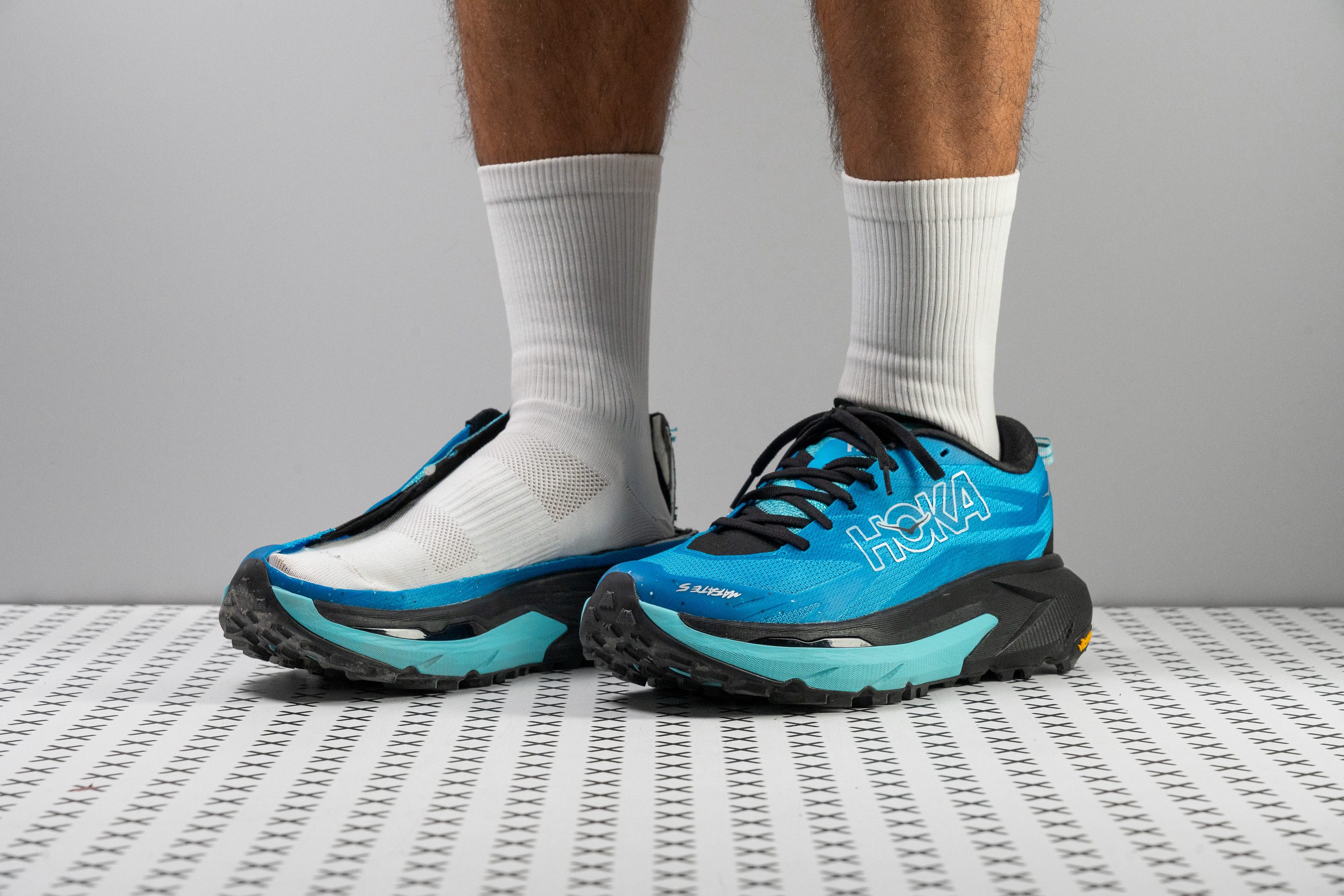Our verdict
Pros
- Even more plush cushioning
- Enhanced energy return
- Roomier fit than most HOKA models
- Durable yet breathable knit upper
- Built for long ultras
- Outstanding Vibram Megagrip rubber
- Same price as the previous version
- Stable for its tall stack
- Solid durability
Cons
- Heavy (and heavier than version 4)
- Tongue design could be much better
- Could be too stiff for some
Audience verdict
Comparison
The most similar running shoes compared
+ + Add a shoe | |||||
|---|---|---|---|---|---|
| Audience score | 71 Bad! | 74 Bad! | 90 Superb! | 88 Great! | |
| Price | $185 | $155 | $185 | $185 | |
| Trail terrain | LightModerate | LightModerate | LightModerate | ModerateTechnical | |
| Shock absorption | High | High | High | Moderate | |
| Energy return | Moderate | Low | Low | Moderate | |
| Traction | High | High | High | - | |
| Arch support | Neutral | Neutral | Neutral | Neutral | |
| Weight lab Weight brand | 11.1 oz / 315g 11.7 oz / 332g | 9.5 oz / 269g 9.7 oz / 275g | 10.8 oz / 305g 10.9 oz / 309g | 10.3 oz / 293g 10.4 oz / 295g | |
| Drop lab Drop brand | 9.0 mm 8.0 mm | 10.1 mm 8.0 mm | 8.6 mm 6.0 mm | 7.2 mm 4.0 mm | |
| Strike pattern | HeelMid/forefoot | Heel | HeelMid/forefoot | Mid/forefoot | |
| Size | - | - | - | True to size | |
| Midsole softness | Soft | Soft | Soft | Soft | |
| Difference in midsole softness in cold | Small | Normal | Small | Normal | |
| Toebox durability | Decent | Good | Good | Good | |
| Heel padding durability | Decent | Good | Good | Good | |
| Outsole durability | Good | Good | Good | Good | |
| Breathability | Moderate | Breathable | Moderate | Moderate | |
| Width / fit | Medium | Medium | Medium | Medium | |
| Toebox width | Medium | Medium | Wide | Narrow | |
| Stiffness | Stiff | Moderate | Moderate | Moderate | |
| Torsional rigidity | Stiff | Stiff | Moderate | Stiff | |
| Heel counter stiffness | Moderate | Stiff | Flexible | Flexible | |
| Lug depth | 4.4 mm | 3.7 mm | 4.1 mm | 3.9 mm | |
| Heel stack lab Heel stack brand | 42.9 mm 45.0 mm | 40.2 mm 42.0 mm | 36.3 mm 38.5 mm | 38.0 mm 33.0 mm | |
| Forefoot lab Forefoot brand | 33.9 mm 37.0 mm | 30.1 mm 34.0 mm | 27.7 mm 32.5 mm | 30.8 mm 29.0 mm | |
| Widths available | Normal | NormalWide | Normal | Normal | |
| Season | All seasons | SummerAll seasons | All seasons | All seasons | |
| Removable insole | ✓ | ✓ | ✓ | ✓ | |
| Orthotic friendly | ✓ | ✓ | ✓ | ✓ | |
| Ranking | #365 Bottom 1% | #360 Bottom 3% | #39 Top 11% | #132 Top 36% | |
| Popularity | #114 Top 31% | #73 Top 20% | #325 Bottom 12% | #103 Top 28% |
Who should buy
We found that the HOKA Mafate 5 truly shines for:
- Trail runners who love long distances and need a shoe with outstanding cushioning and solid durability, even at a premium price.
- Fans of the Mafate Speed 4 who don’t mind a bit of extra weight, because almost everything else is improved, especially the midsole.
- Ultrarunners looking for a versatile, high-mileage workhorse for both training and racing.
- Runners who avoided previous HOKAs because of their low drop. Well, this version finally offers a higher one.
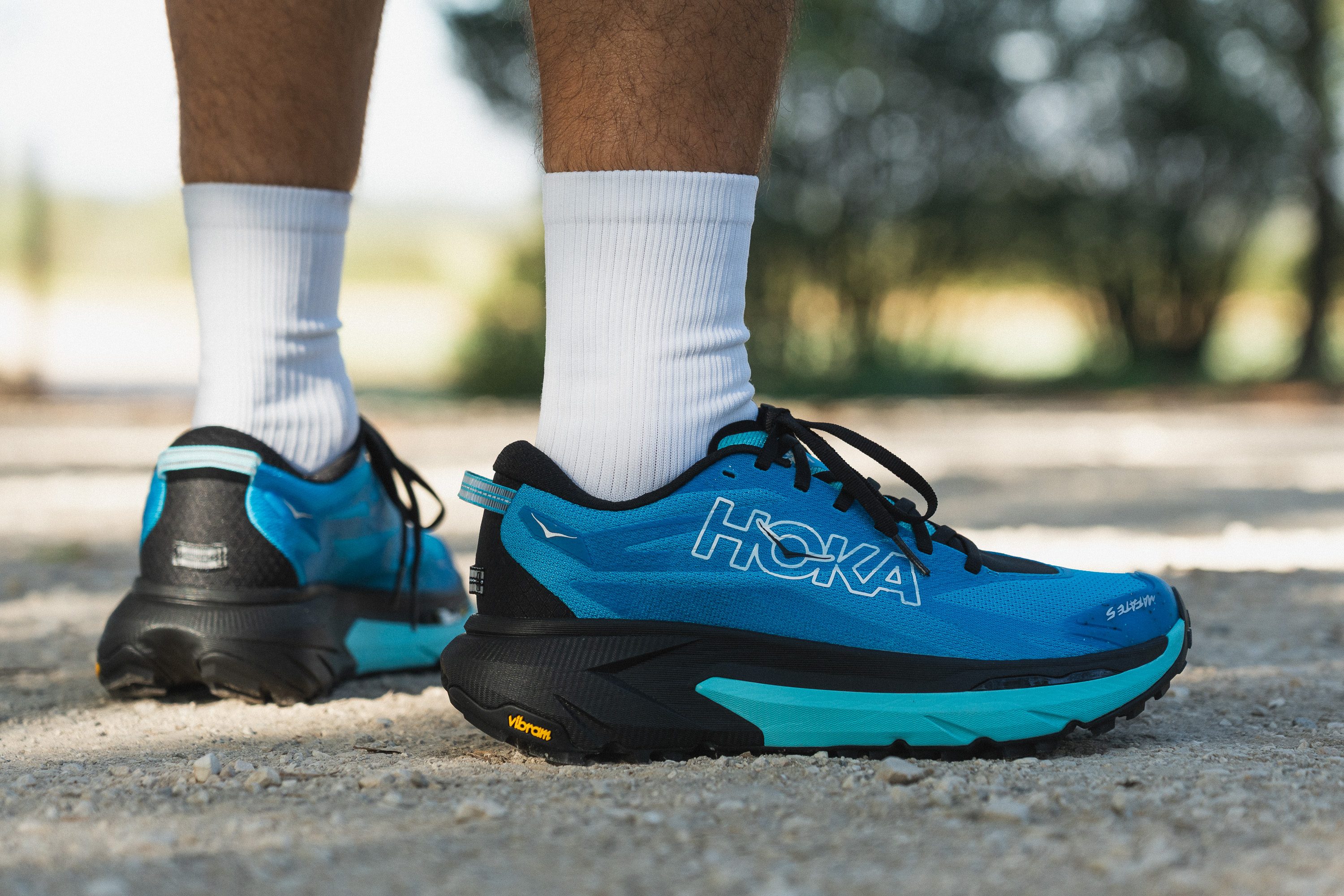
Who should NOT buy
We think the HOKA Mafate 5 is not the best choice for runners who prefer a connected feel. Its towering stack height and rigid geometry create a distant sensation from the terrain. Based on our testing, shoes like the NNormal Kjerag or the Nike Wildhorse 10 offer a more natural, ground-sensitive experience with greater flexibility and control.
We also believe that the Mafate 5’s heavy build makes it less ideal for some runners. In our view, lighter alternatives such as the HOKA Tecton X 3—if budget allows—or the more affordable HOKA Speedgoat 6 provide a faster feel.
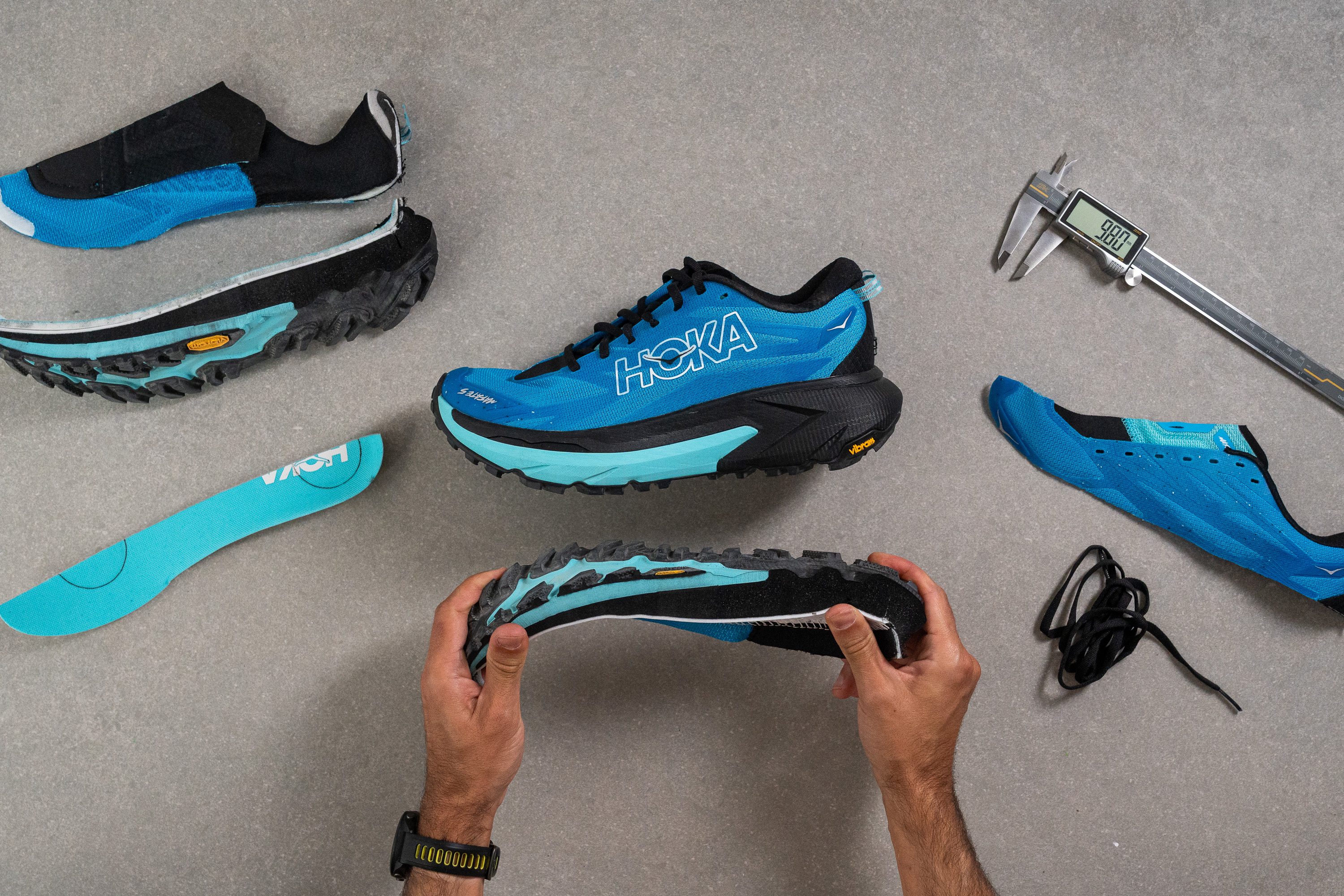
Cushioning
Shock absorption
The HOKA Mafate 5 now delivers world-class cushioning, especially under the heel. After testing the shoe in our lab, we measured an impressive 160 SA in the rear and 117 SA in the forefoot.
To put these numbers into perspective, check our interactive chart to compare it with other models. You’ll clearly see the massive leap versus the Mafate Speed 4, whose heel only reached 129 SA in the heel.
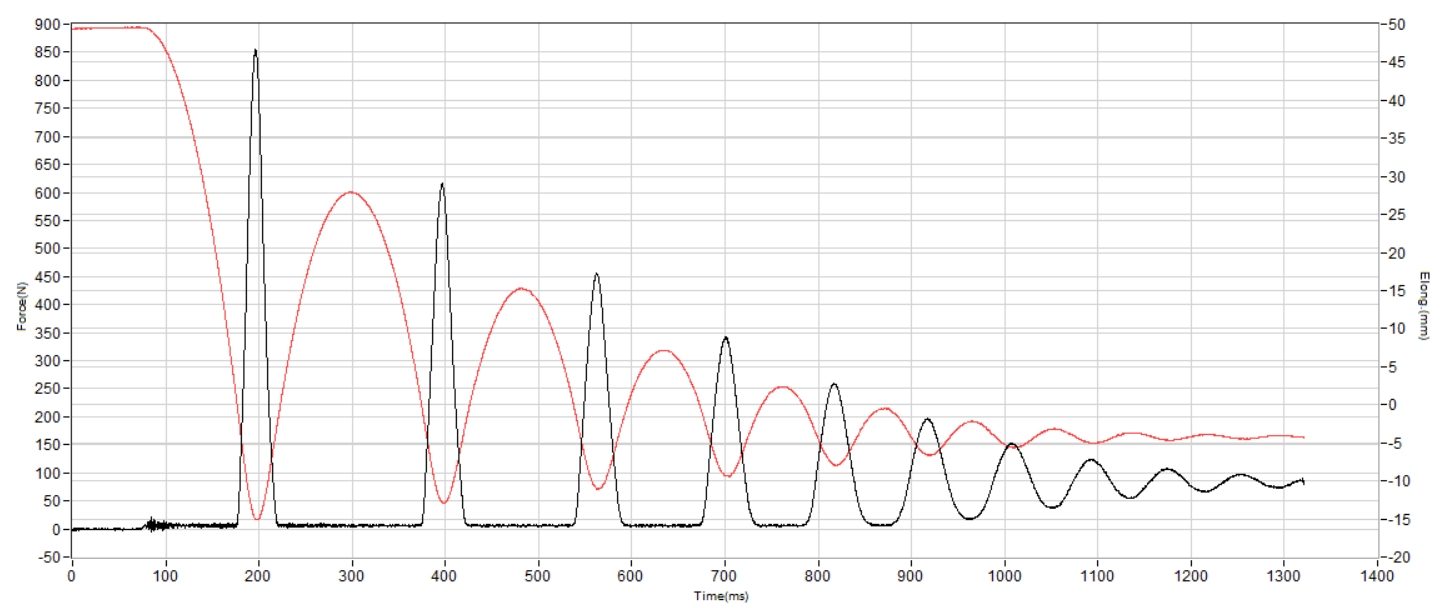
| Mafate 5 | 160 SA |
| Average | 122 SA |
Energy return
Energy return also improved, jumping from 58.3% to 63.7%. It’s a strong result for a trail shoe and fits perfectly with the premium price tag of the Mafate 5. The ride feels responsive, something crucial given the shoe’s heavy build.
And we think that the new dual-foam setup of the Mafate 5 works very well. It features a mix of supercritical EVA—light and energetic—with a smaller layer of firmer compression-molded EVA for extra stability and durability.
| Mafate 5 | 63.7% |
| Average | 55.6% |
Heel stack
HOKA removing the “Speed” from the Mafate name wasn’t a random marketing choice—it marks the shoe’s full embrace of a maximalist identity, featuring a towering 42.9 mm stack height in the heel.
This design makes it more suited than ever for ultra-distance runners and anyone who loves a deep, foam-heavy feel underfoot. However, if you prefer a lower-profile, more ground-connected trail ride, the Mafate 5 is just the opposite.
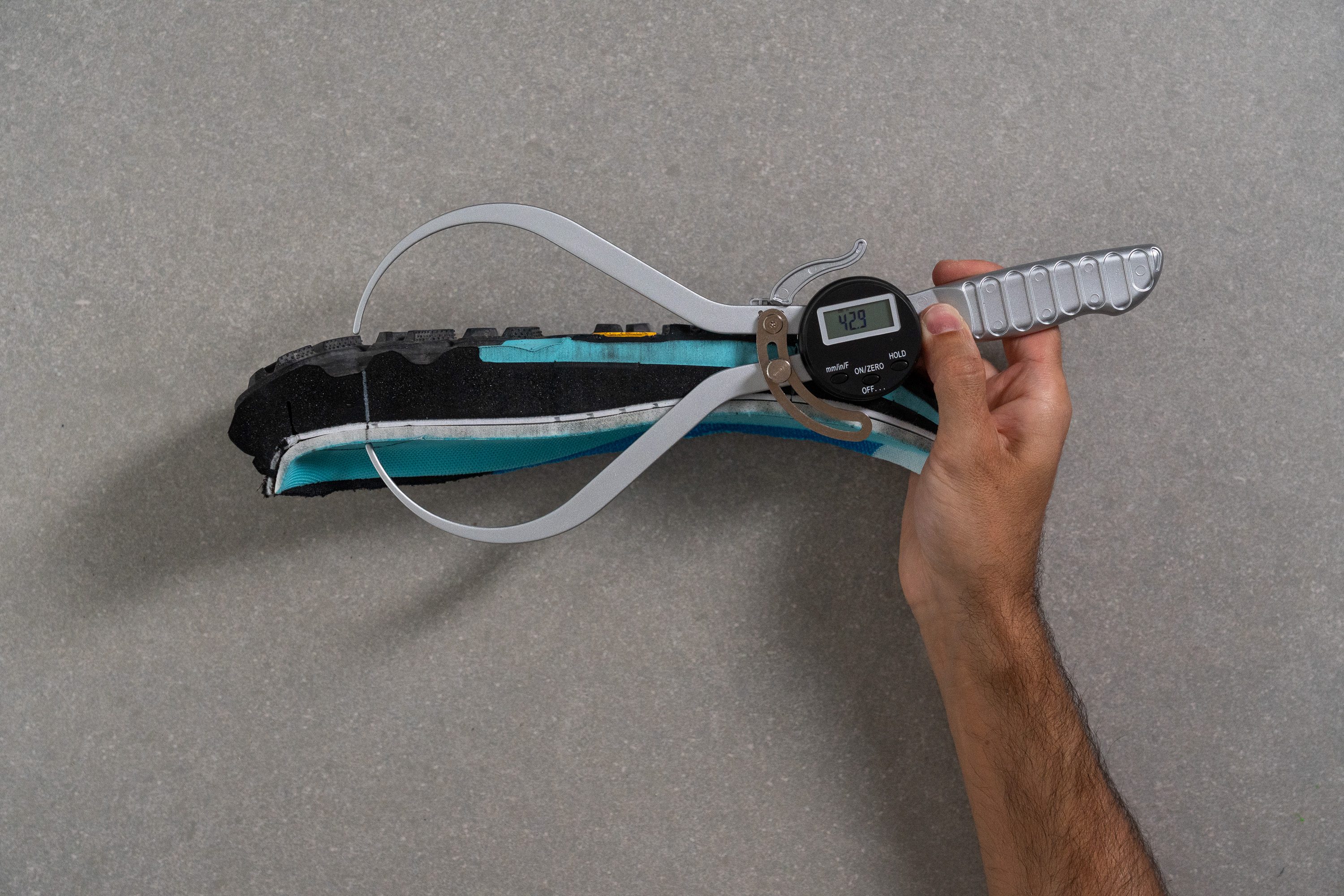
| Mafate 5 | 42.9 mm |
| Average | 32.6 mm |
Forefoot stack
The forefoot mirrors the heel’s evolution, breaking the 30 mm barrier and reaching 33.9 mm. Honestly, it feels like HOKA pulled the same move here as with the Clifton 9 to Clifton 10 transition.
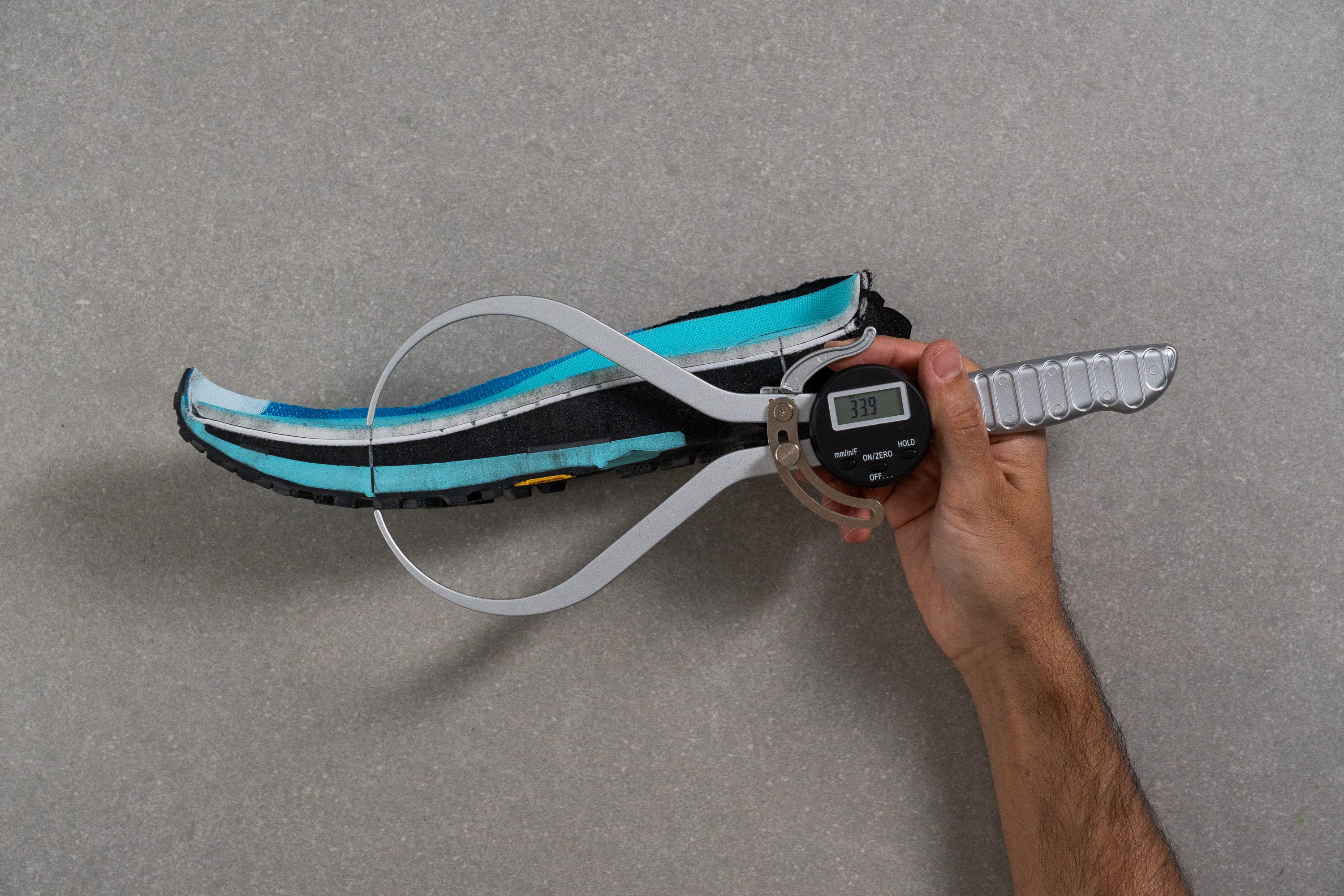
| Mafate 5 | 33.9 mm |
| Average | 25.1 mm |
Drop
Another shift we’ve seen from HOKA lately is their move away from low-drop setups. The Mafate 5 now features an official 8 mm offset, and we measured a slightly higher 9.0 mm. Nonetheless, that 1 mm difference is impossible to feel underfoot.
With this geometry change, HOKA aims to appeal to heel strikers, making the shoe feel more natural and dynamic to them.
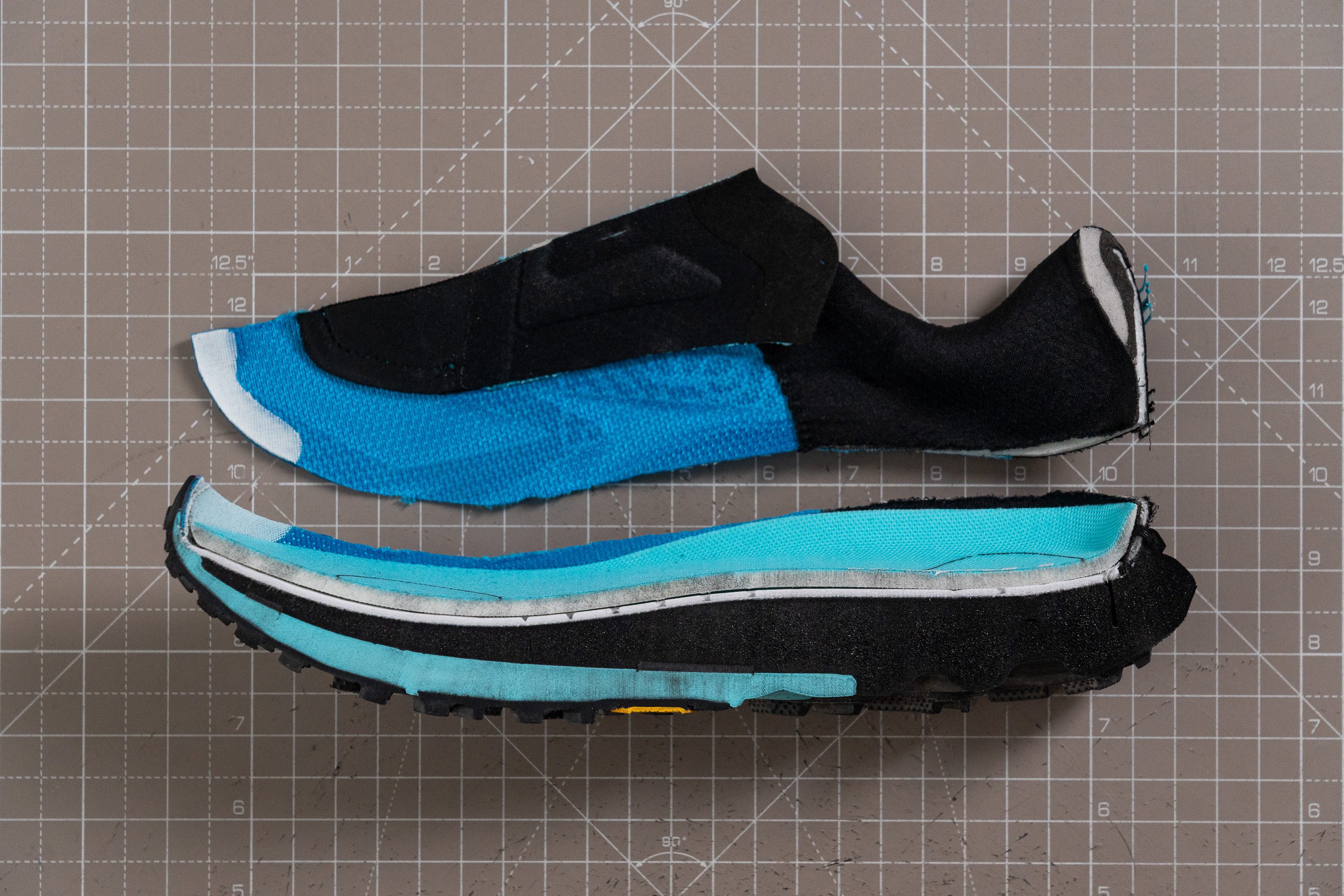
| Mafate 5 | 9.0 mm |
| Average | 7.5 mm |
Midsole softness
HOKA has brought its supercritical EVA foam—already proven in trainers like the Mach 6—to the Mafate 5. This lightweight, lively, and soft compound scored just 15.8 HA in our durometer, confirming its plush feel.
However, we can’t help but think the shoe would’ve been even better if the entire midsole used this foam instead of mixing it with standard EVA...
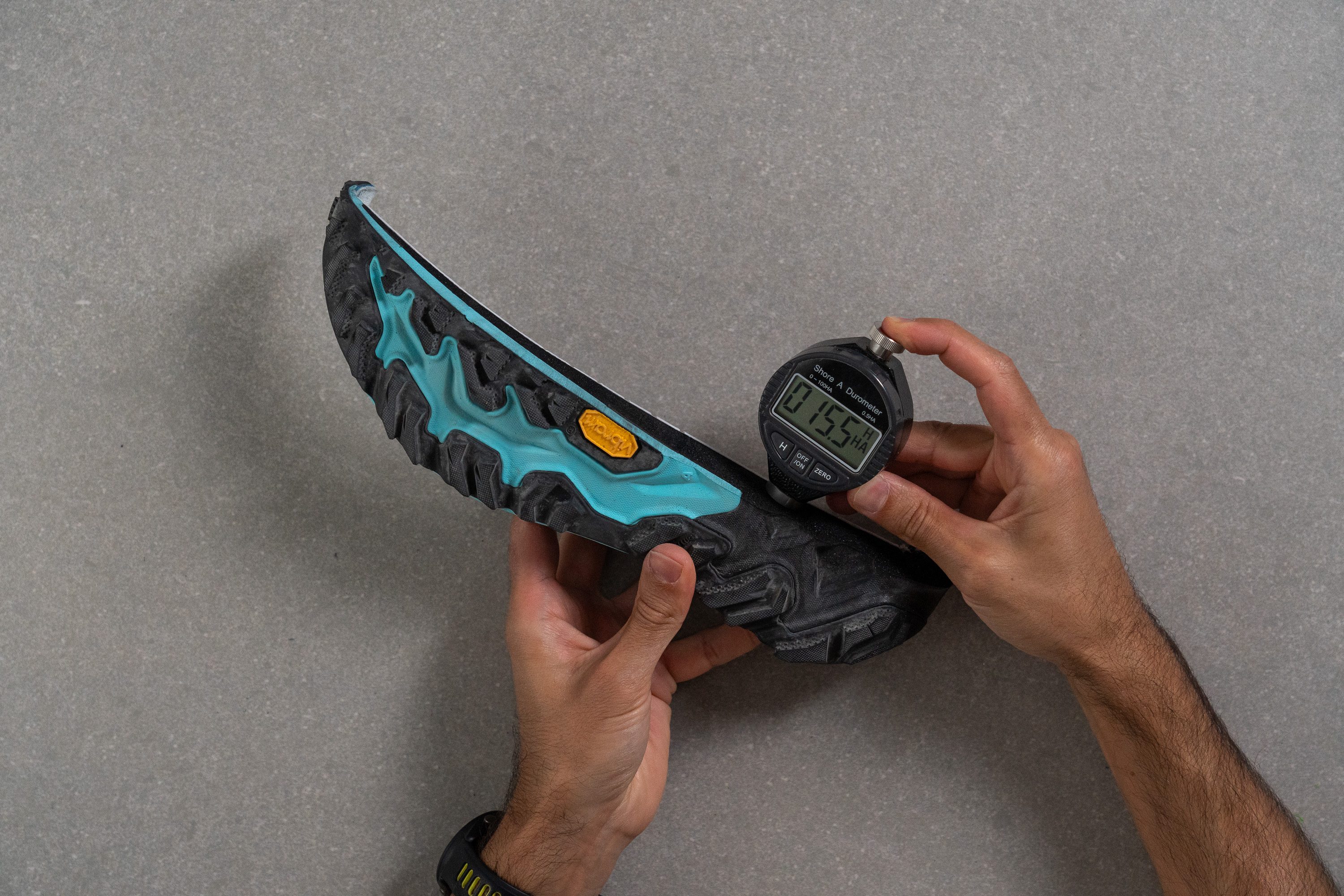
| Mafate 5 | 15.8 HA |
| Average | 21.9 HA |
Secondary foam softness
The secondary foam in the Mafate 5 is a blue CMEVA layer placed in the forefoot. It feels firmer yet still comfortably soft at 17.5 HA, and we discovered that its placement isn’t random at all, but directly linked to the outsole’s weight-saving layout.
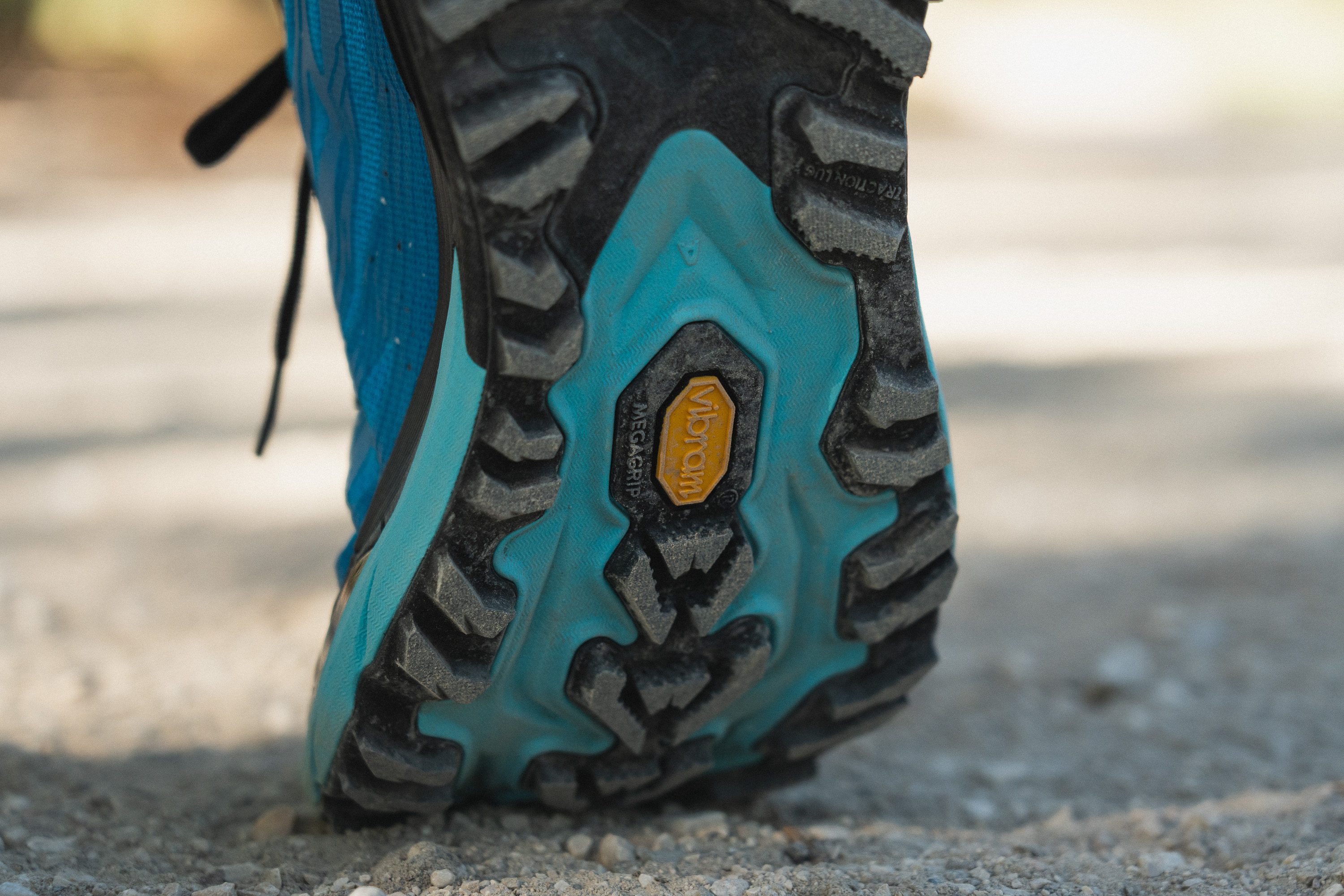
This shoe features a lot of exposed foam in the forefoot, and the supercritical EVA would wear out too fast. So we believe that HOKA had two choices: fully cover it with heavy Vibram rubber or expose a more durable EVA. They chose the latter.
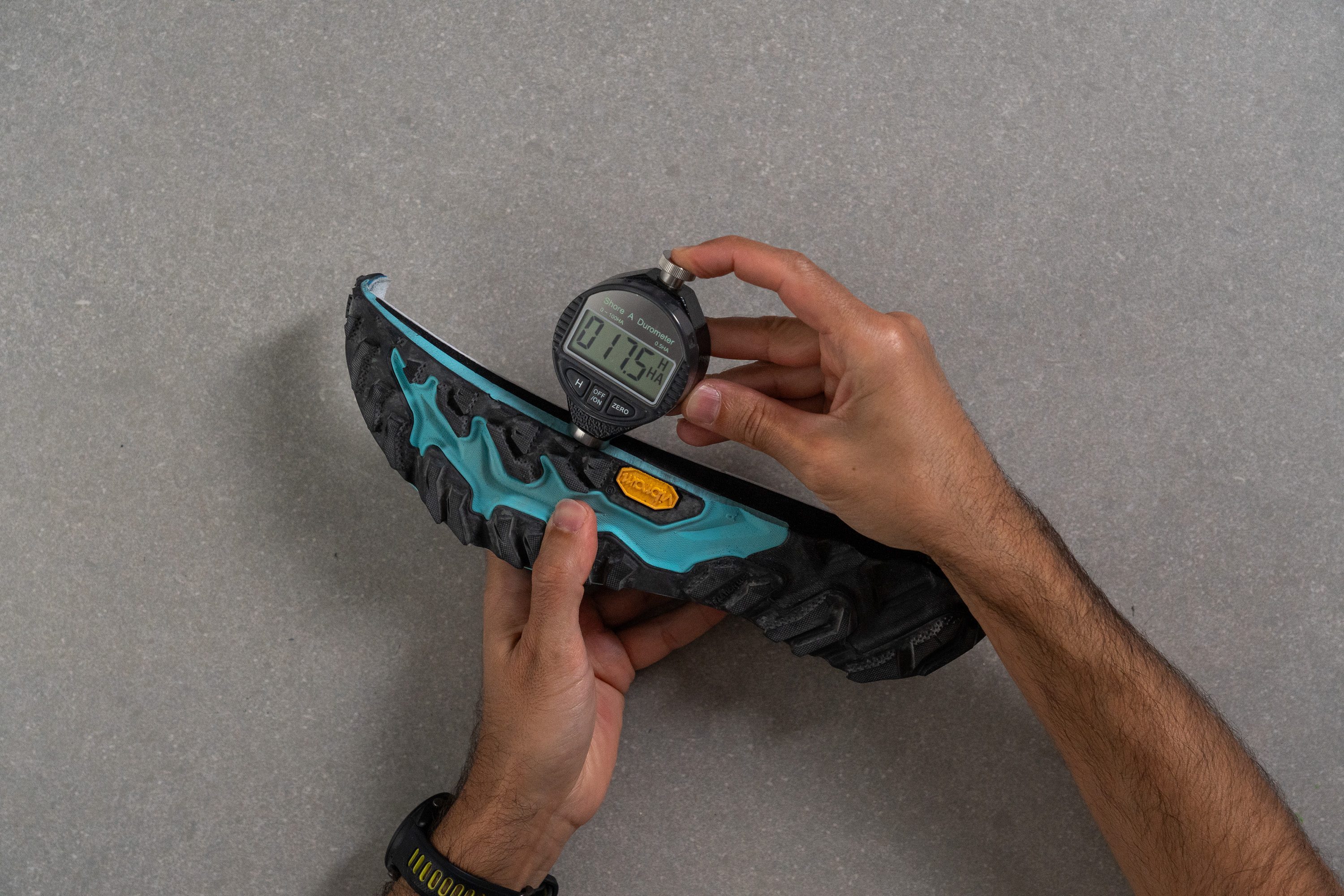
| Mafate 5 | 17.5 HA |
| Average | 25.5 HA |
Rocker
More stack height? No problem... more rocker! To balance the extra foam in both the heel and forefoot, HOKA gave the Mafate 5 a noticeably curved front that promotes smoother transitions. However, this design makes it less appealing to those who enjoy flatter, more natural-feeling midsoles.
The heel is also more curved than ever in this series, in another nod to rearfoot strikers.
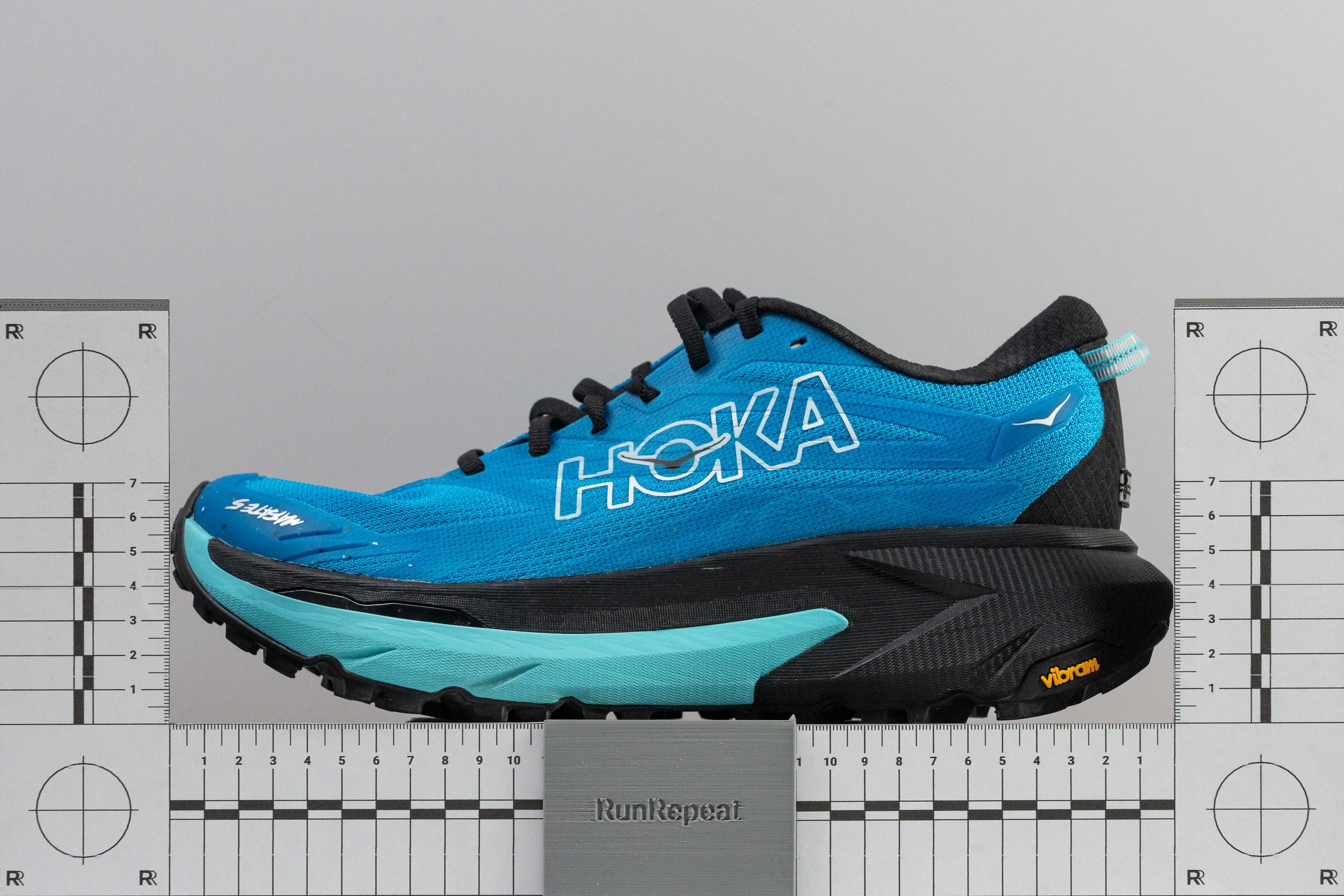
Plate
A new addition to the Mafate 5 is the Rocker Integrity Technology. It's a stiffening piece in the forefoot that maintains the rocker shape and improves stability with wing-like extensions typical of HOKA plates.
It’s not a classic carbon plate as you can see, but we discovered that it noticeably increases stiffness, keeping the ride steady even as the foam softens over time.
Size and fit
Size
Width / Fit
HOKA is widely known for its snug-fitting designs, but the Mafate 5 takes a different route, and we’re really glad it does. This change makes perfect sense, as the shoe is clearly built for long-distance, multi-hour mountain adventures.
After our gel mold of the interior solidified in the refrigerator, we discovered a surprisingly generous width of 95.5 mm. This is quite roomy for a HOKA!
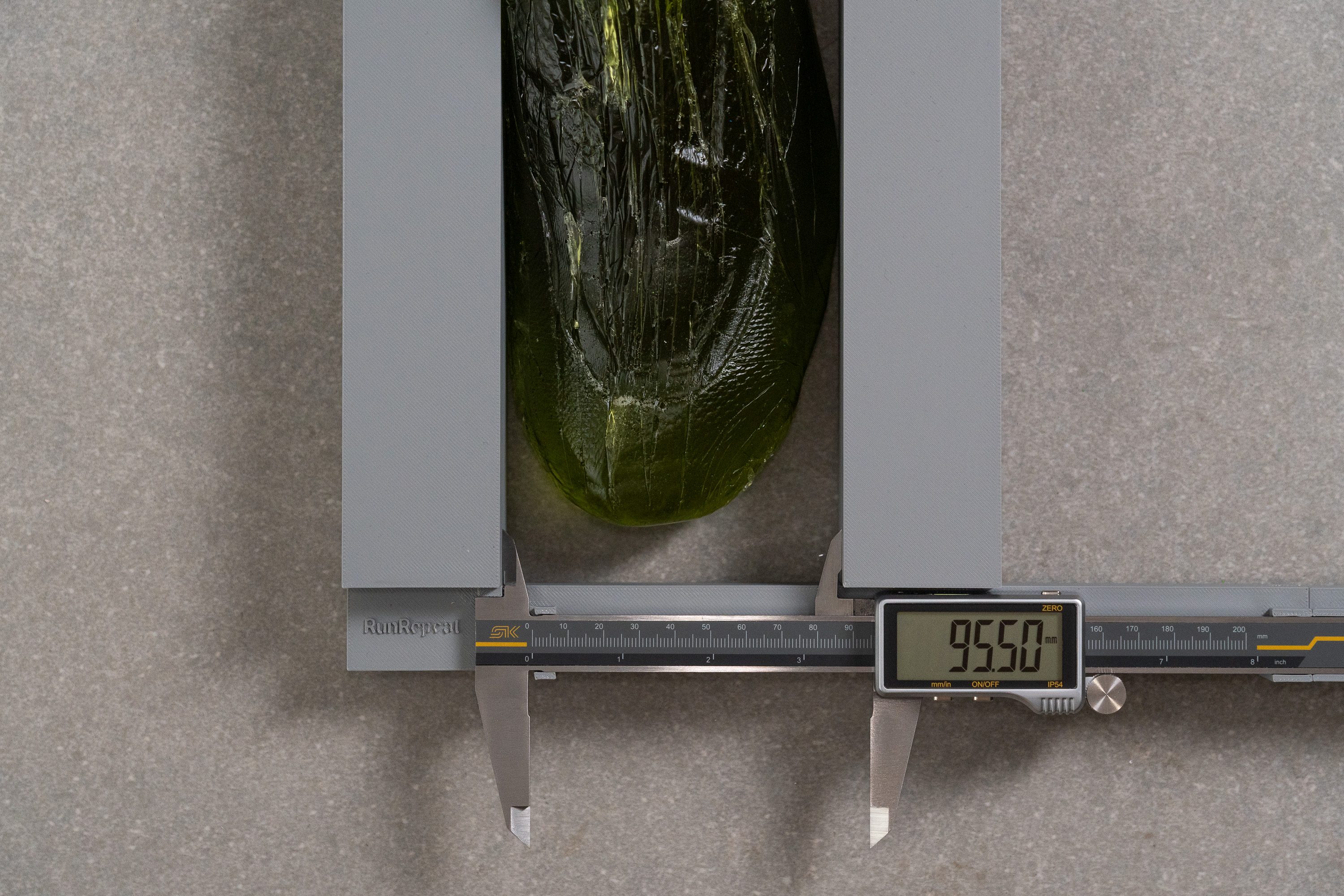
| Mafate 5 | 95.5 mm |
| Average | 95.7 mm |
Toebox width
The toebox, often the most problematic area in many HOKA trail shoes, takes a pleasant turn here. The Mafate 5 measured 74.2 mm, very close to the average trail shoe and providing a much more comfortable fit.
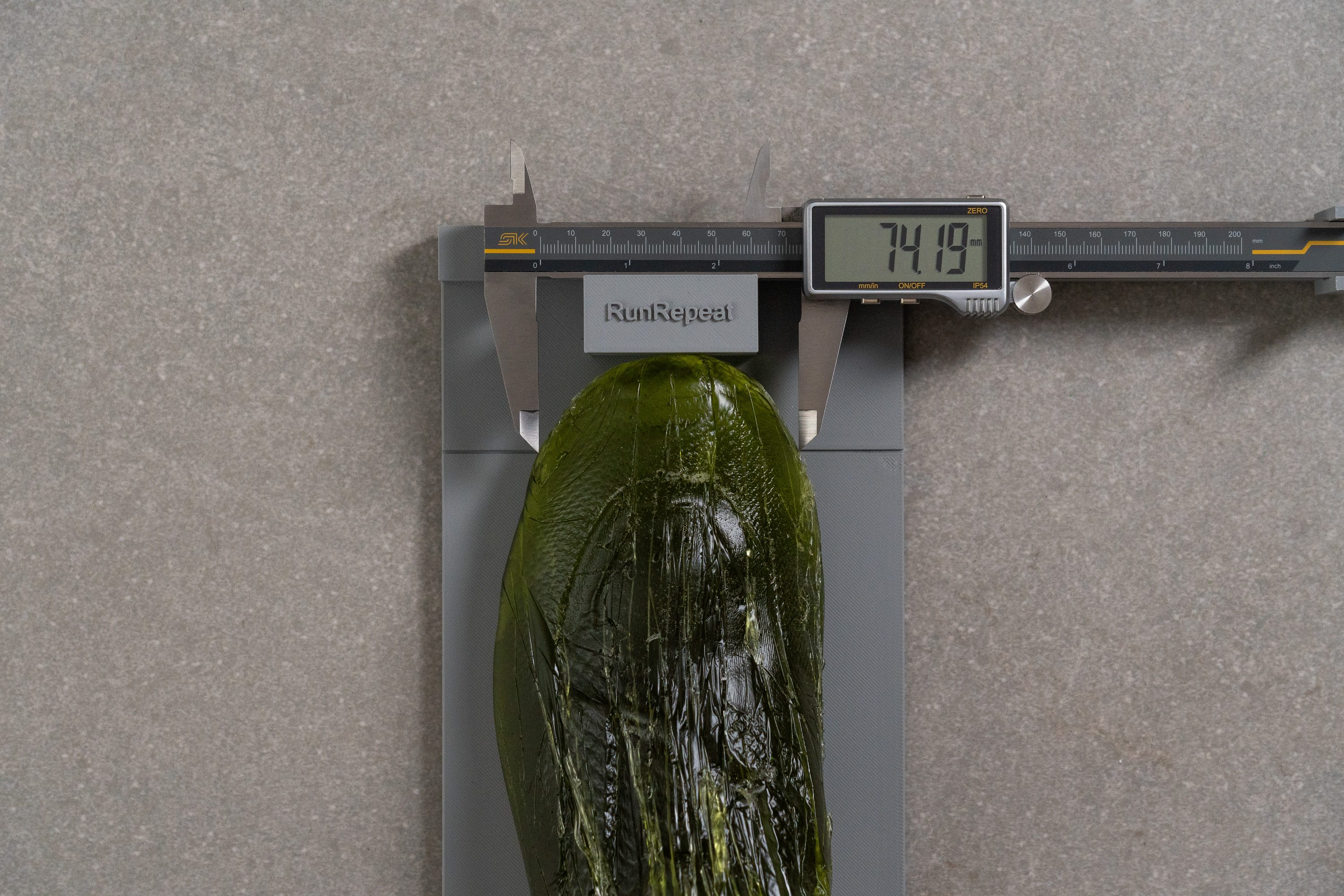
| Mafate 5 | 74.2 mm |
| Average | 74.7 mm |
Toebox height
We also measured the height of the toebox to better understand its internal space.
It reached 25.4 mm, confirming a secure fit with slightly limited vertical toe movement. In our testing, this semi-snug configuration felt good, providing extra security during downhill runs.
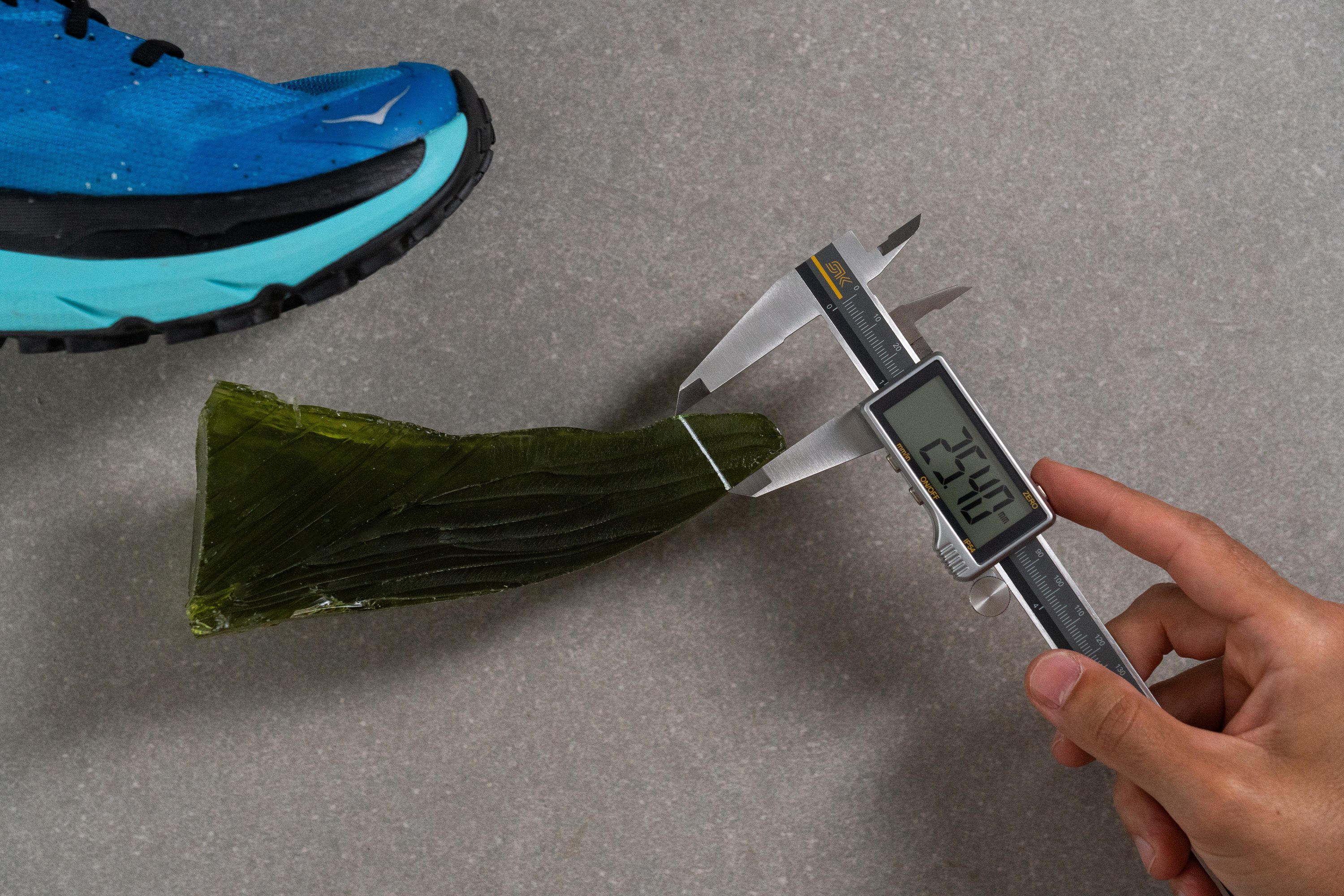
| Mafate 5 | 25.4 mm |
| Average | 27.1 mm |
Traction / Grip
Forefoot traction
The HOKA Mafate 5 uses Vibram Megagrip rubber on its outsole, although HOKA skipped the Litebase version this time, likely for better durability. As expected from Vibram, it delivered a strong 0.66 score that offers reliable grip on almost any surface.
| Mafate 5 | 0.66 |
| Average | 0.60 |
Lug depth
The lugs of the Mafate 5 measure 4.4 mm, which is probably a smart design choice for a shoe that wants to be as versatile as possible. Maybe in the most extreme conditions it lacks grip or those are too deep for pancake-flat dirt roads, but the shoe performs amazingly everywhere else.
On top of that, the lugs come with Vibram's Traction Lug technology, which is a plus that, to be honest, we expected due to the price of the shoe. And delivers the usual confident ride from other Mafates.
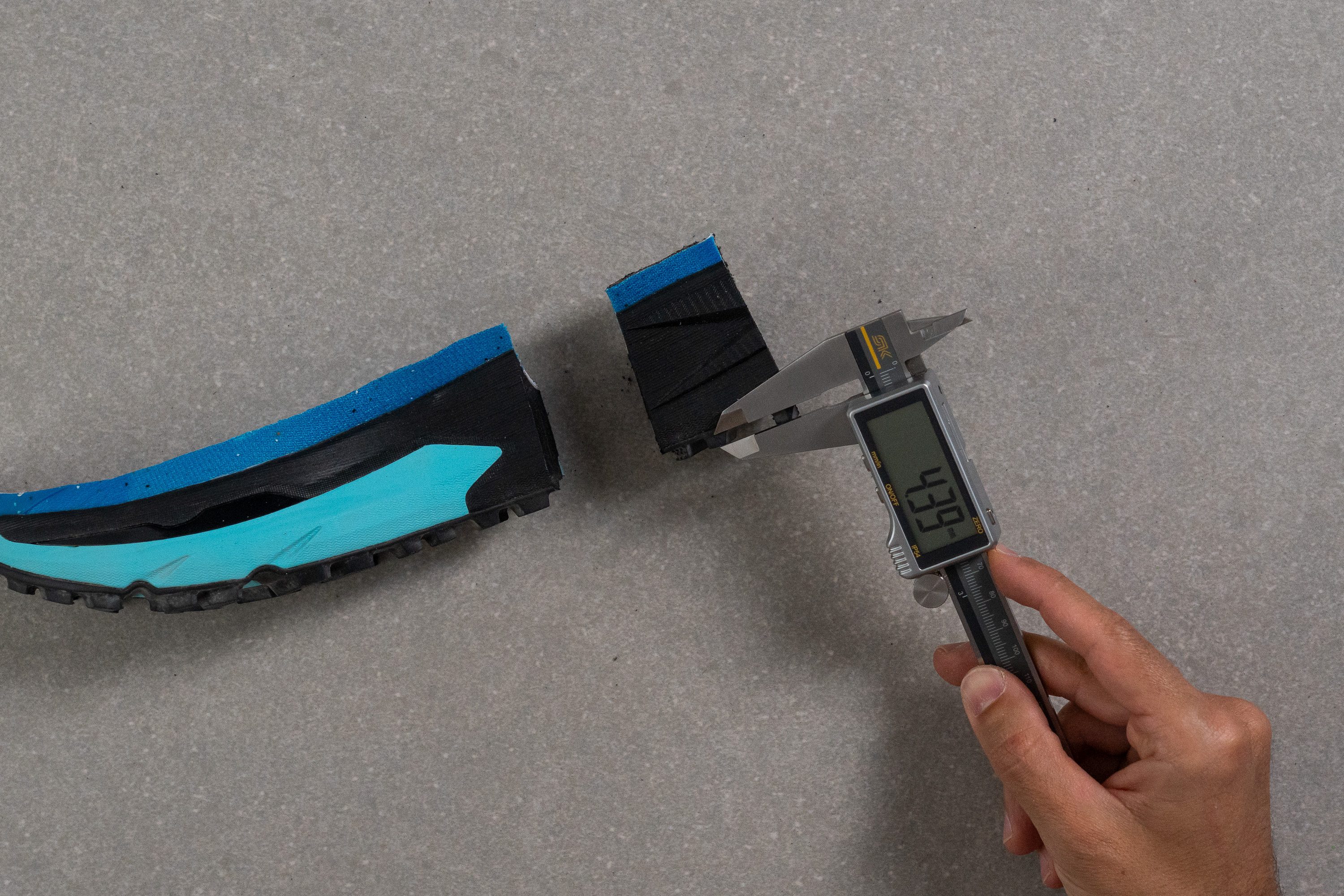
| Mafate 5 | 4.4 mm |
| Average | 3.5 mm |
Outsole design
The outsole offers full rubber coverage on the heel and exposes a section of foam in the midfoot and forefoot, as mentioned earlier in this review.
It stands out for its lower lug density, with most lugs positioned along the outer edge and a single central row of wide lugs through the forefoot. This rare layout also helps the shoe manage muddy terrain more effectively.
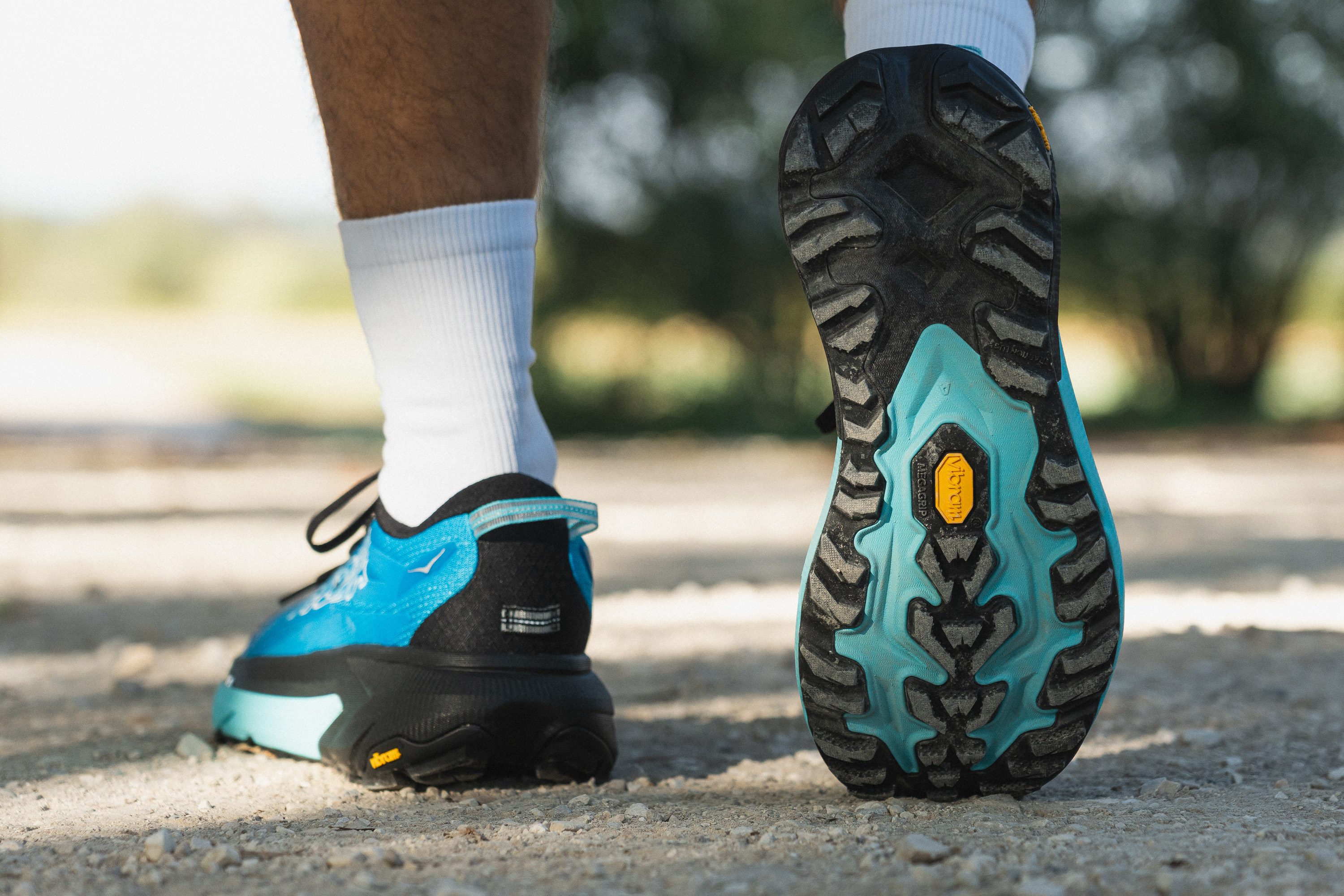
Flexibility / Stiffness
With the increased stack height and the addition of the Rocker Integrity Technology system, the Mafate 5 turned out slightly stiffer than its predecessor. In our 30-degree bend test, the Mafate Speed 4 measured 14.1N, while this new version reached 17.1N.
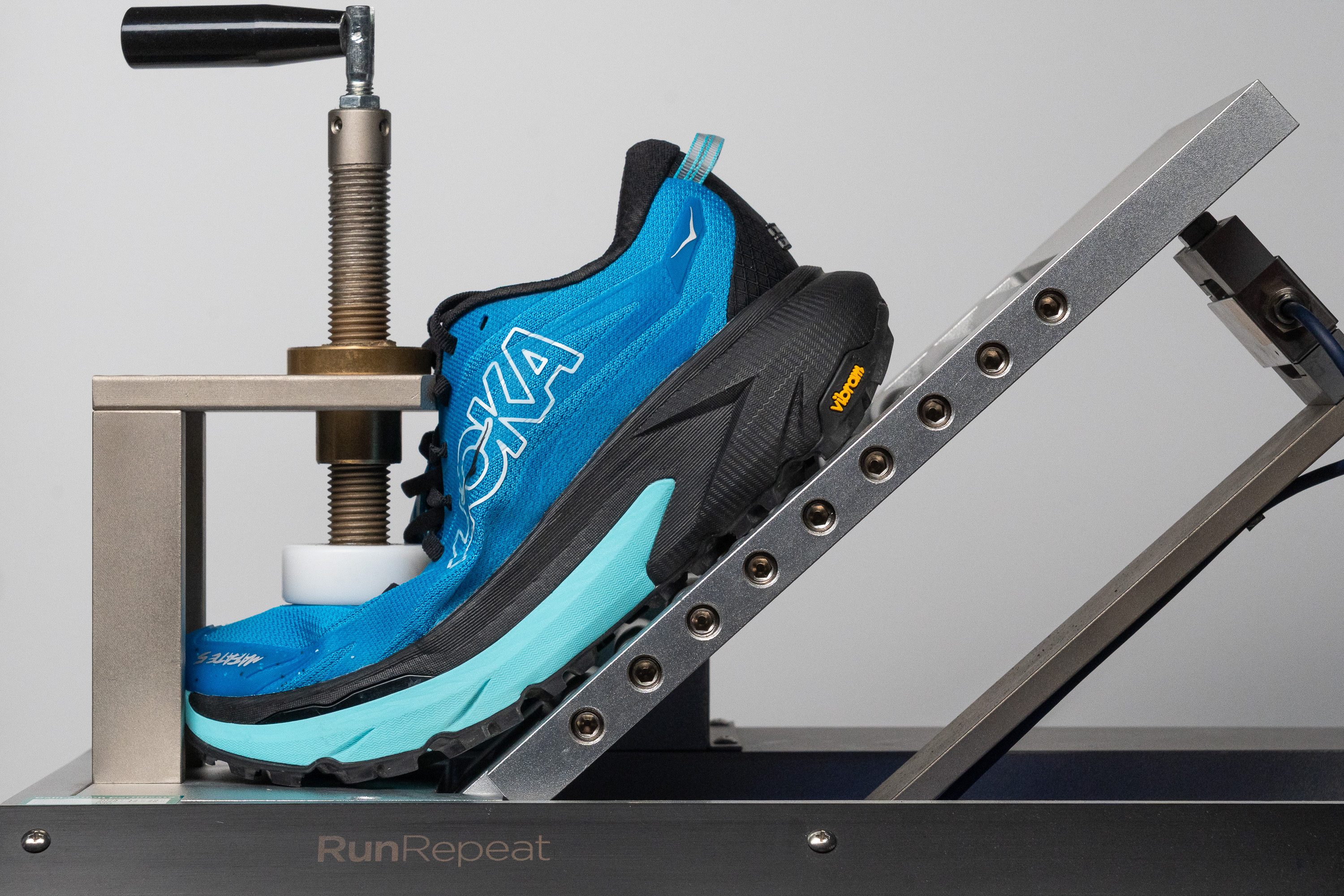
| Mafate 5 | 17.1N |
| Average | 14.6N |
Weight
The Mafate 5 is heavier than its predecessor, which isn’t surprising considering the extra foam added to its midsole. It now weighs 11.1 oz or 315g.
Although the weight is fair for such a large shoe, it does feel noticeably heavy underfoot. For us, it's something to keep in mind if you prefer a lighter ride.
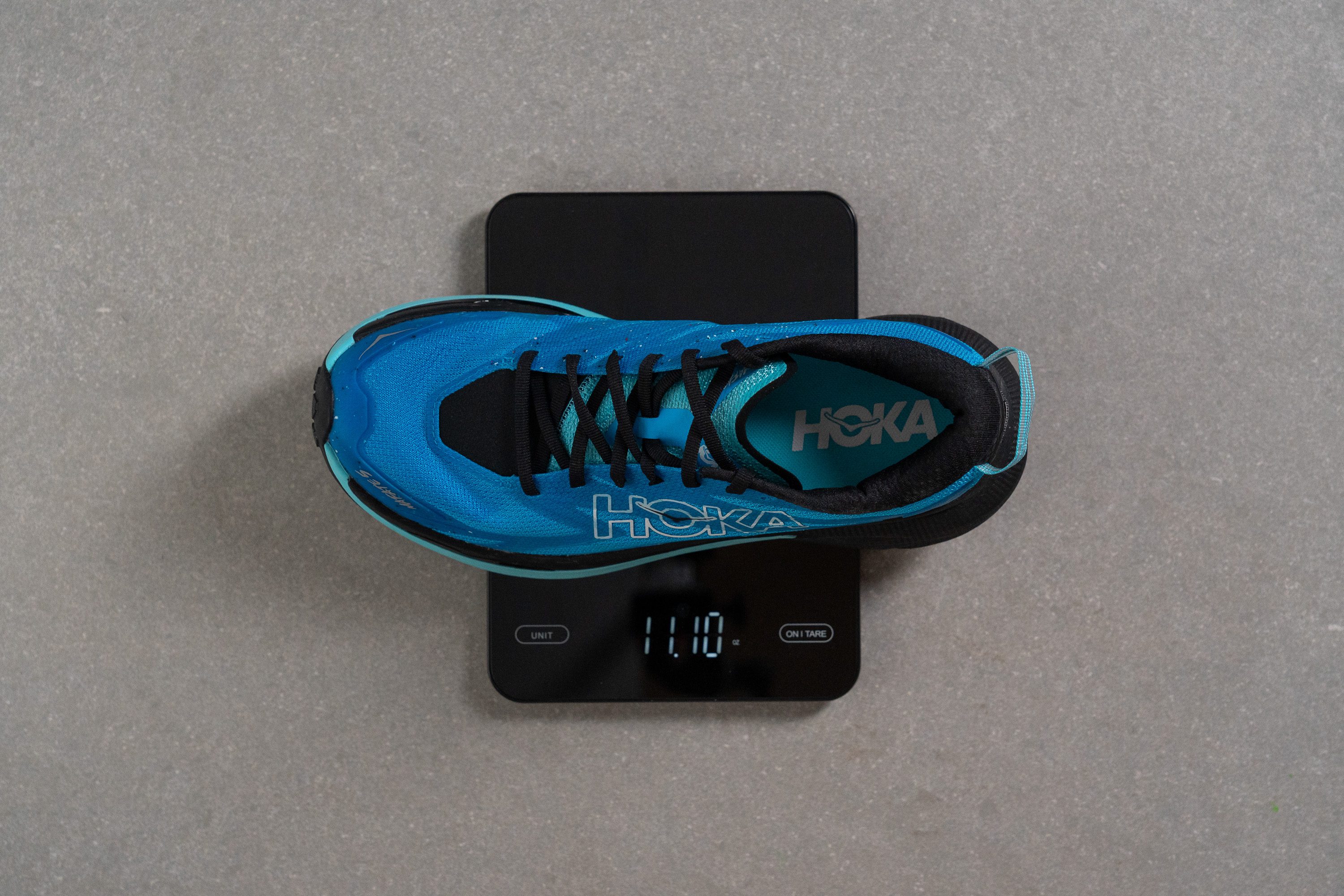
| Mafate 5 | 11.1 oz (315g) |
| Average | 10.2 oz (289g) |
Breathability
The upper of the Mafate 5 marks a significant shift from previous designs, as HOKA replaced the engineered mesh with a warp knit upper that feels more premium and features a special anti-fray treatment. It’s a more refined, high-quality construction that immediately stands out.
We tested its breathability and found it performs very well, scoring 4/5 in our lab test. This was a pleasant surprise, since trail shoes usually sacrifice ventilation for protection. In this case, airflow felt consistent and efficient throughout.
When moving the upper over a LED light, we easily spotted the areas with the most ventilation. Interestingly, instead of restricting breathability to the toebox like most brands do, HOKA extended airflow to the midfoot section too, improving overall comfort during longer summer runs.
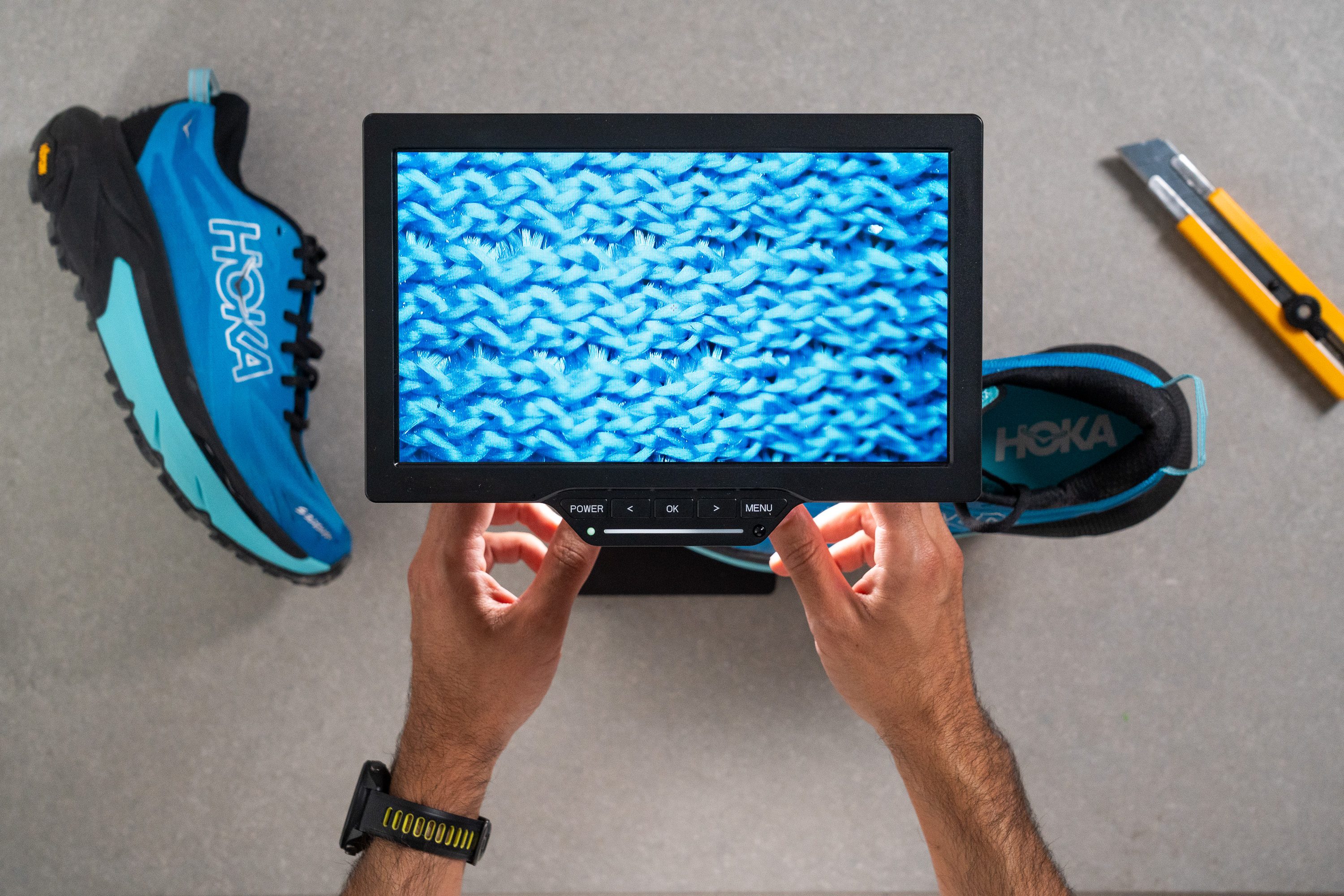
Under the microscope, the knit doesn’t look particularly breathable at first glance.
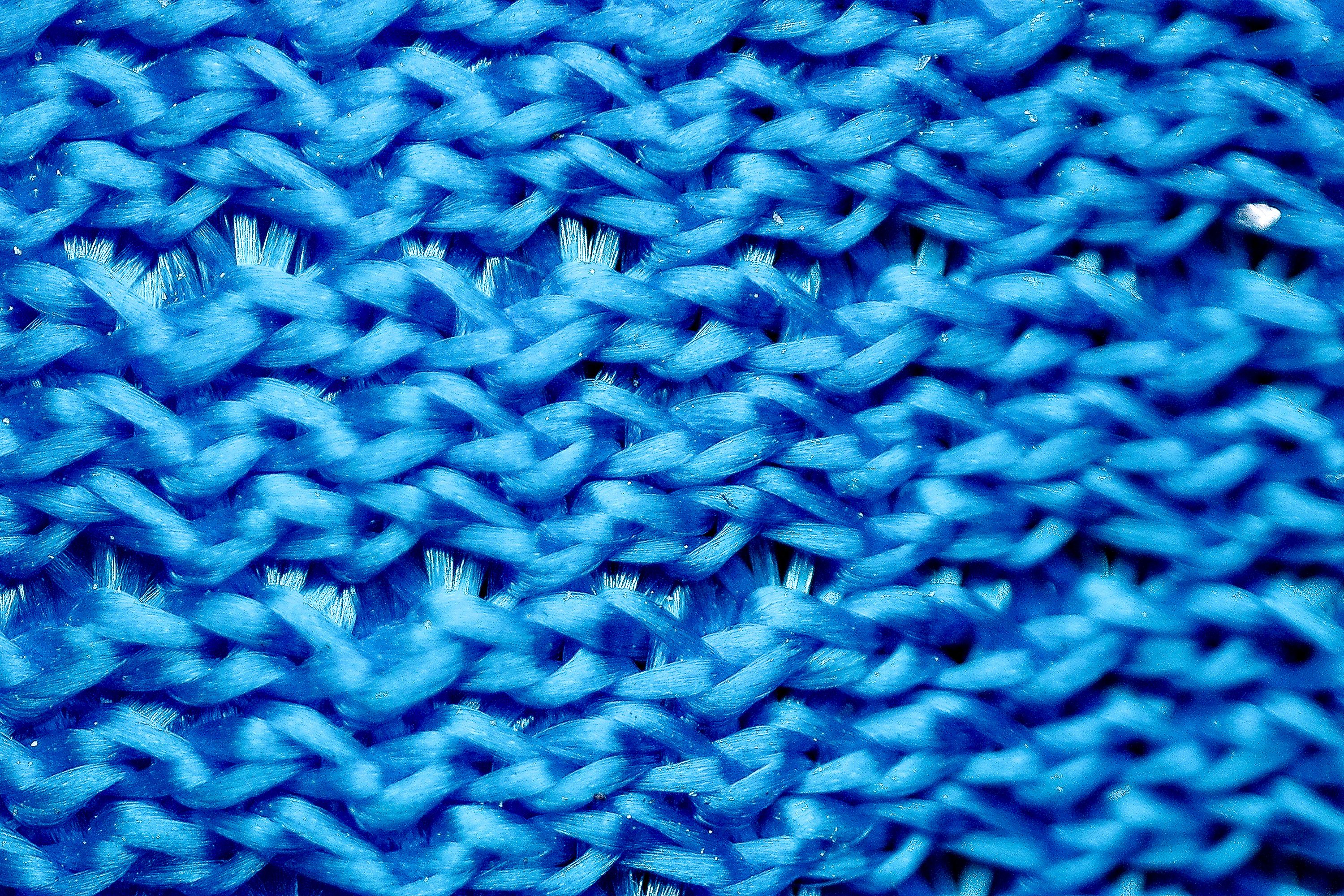
This shows the importance of combining visual analysis with real airflow testing, as the results proved the upper performs far better than it appears.
Overall, we’re genuinely pleased with the design and performance.
| Mafate 5 | 4 |
| Average | 3.2 |
Stability
Lateral stability test
The HOKA Mafate 5 makes a strong effort to deliver a stable ride despite its towering stack height. We found that the Rocker Integrity Technology, with its forefoot wings, wide midsole, and supportive TPU cage, all work together to enhance stability.
Torsional rigidity
The Mafate 5 lives up to its version, earning a 5/5 in our torsional rigidity test. It’s exactly what we expected given the massive stack height and thick Vibram outsole.
This setup keeps the shoe stable on flat terrain but limits adaptability, making it less suitable for runners who prefer a more flexible feel underfoot.
| Mafate 5 | 5 |
| Average | 3.6 |
Heel counter stiffness
We observed that HOKA slightly modified the heel counter. In version 4, it was likely too pliable, scoring just 2/5 on our scale. Now, it’s firmer and more secure, yet still comfortable at 3/5.
| Mafate 5 | 3 |
| Average | 3 |
Midsole width - forefoot
One thing deeply rooted in the Mafate series DNA is its extra-wide midsole.
It greatly enhances stability but also gives the shoe a less agile, heavy-footed feel. We measured an impressive 119.2 mm in the forefoot, far above the average.
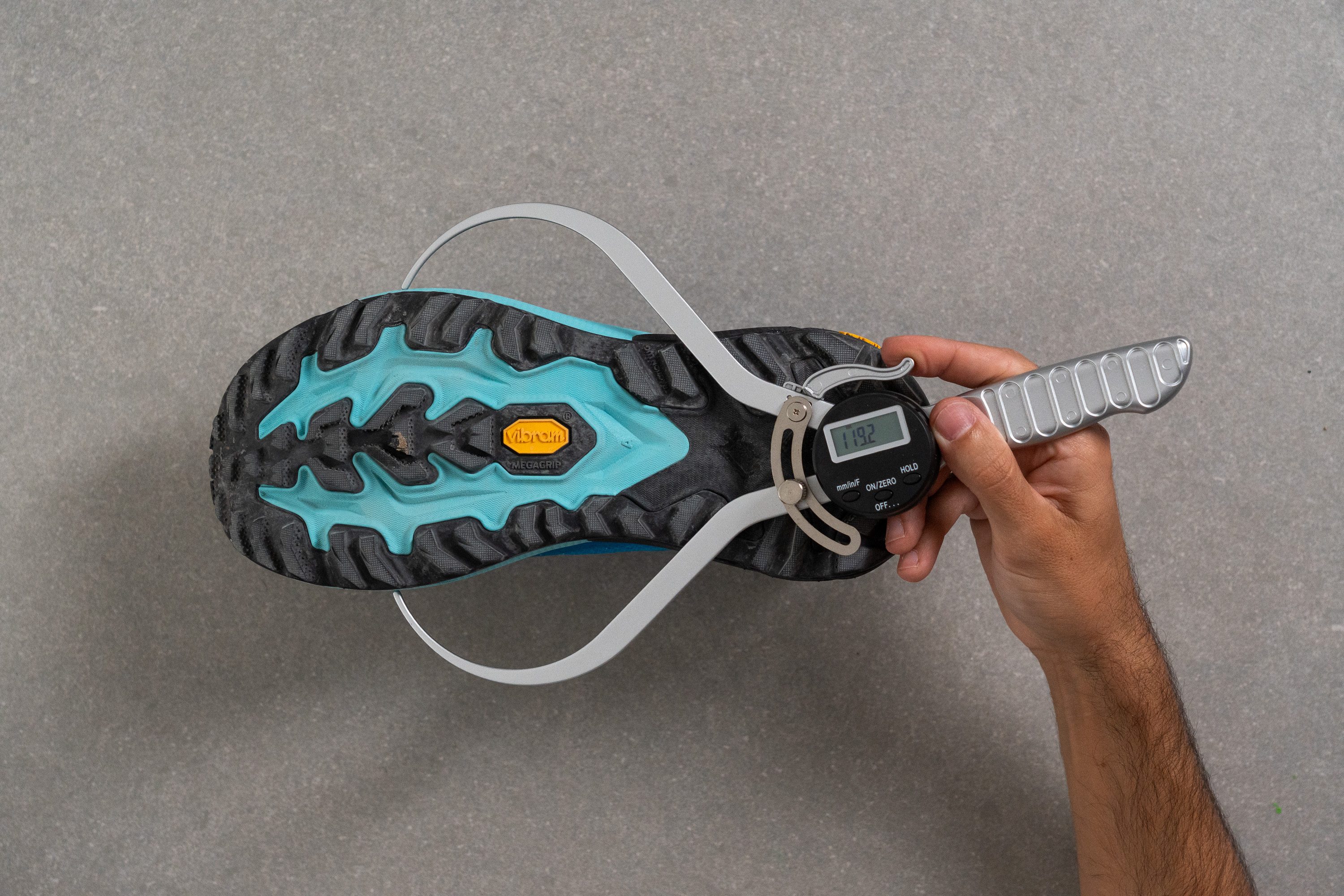
| Mafate 5 | 119.2 mm |
| Average | 112.8 mm |
Midsole width - heel
The heel is impressively wide at 98.7 mm, reinforcing the Mafate 5’s ultra-wide design and giving it a tank-like presence. It’s especially good news for heel strikers seeking extra support.
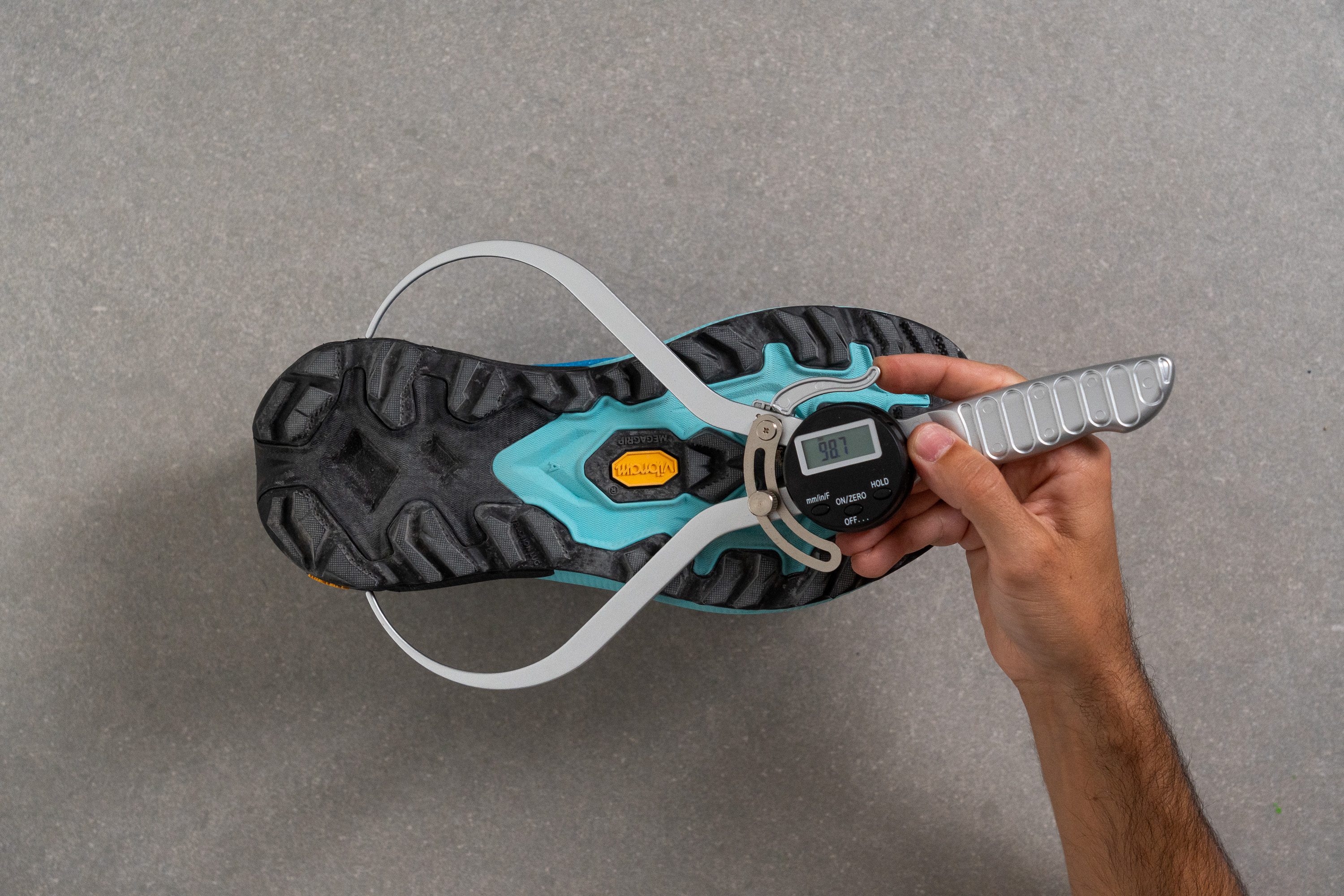
| Mafate 5 | 98.7 mm |
| Average | 89.9 mm |
Durability
Toebox durability
The toebox comes with a big heat-sealed TPU reinforcement. Even so, we wanted to test the durability of the knit upper, as this material is usually weaker than engineered mesh. But to our delight, it scored a 3/5 and clears any worry!
| Mafate 5 | 3 |
| Average | 3.1 |
Heel padding durability
The heel padding earned the same 3/5 score, though we expected a bit more from it. It’s not a real drawback, but we’d love to see a 4 or 5 in the next Mafate.
| Mafate 5 | 3 |
| Average | 3 |
Outsole durability
It’s hard to understand why some brands still try to reinvent trail rubber compounds instead of simply partnering with Vibram. Even Nike did it after years of experimenting, introducing the Ultrafly with Vibram rubber. So we’re happy that HOKA continues its collaboration with the Italian brand, as the Megagrip compound remains ultra-reliable and durable.
During our lab test, we discovered that only 0.5 mm of rubber wore away. That's a long-lasting result that confirms the Mafate 5’s rugged build.
| Mafate 5 | 0.5 mm |
| Average | 0.9 mm |
Outsole thickness
HOKA took a cautious approach by adding 2.4 mm of outsole thickness, not counting the lugs. It provides extra protection but also contributes a bit more weight to the shoe.
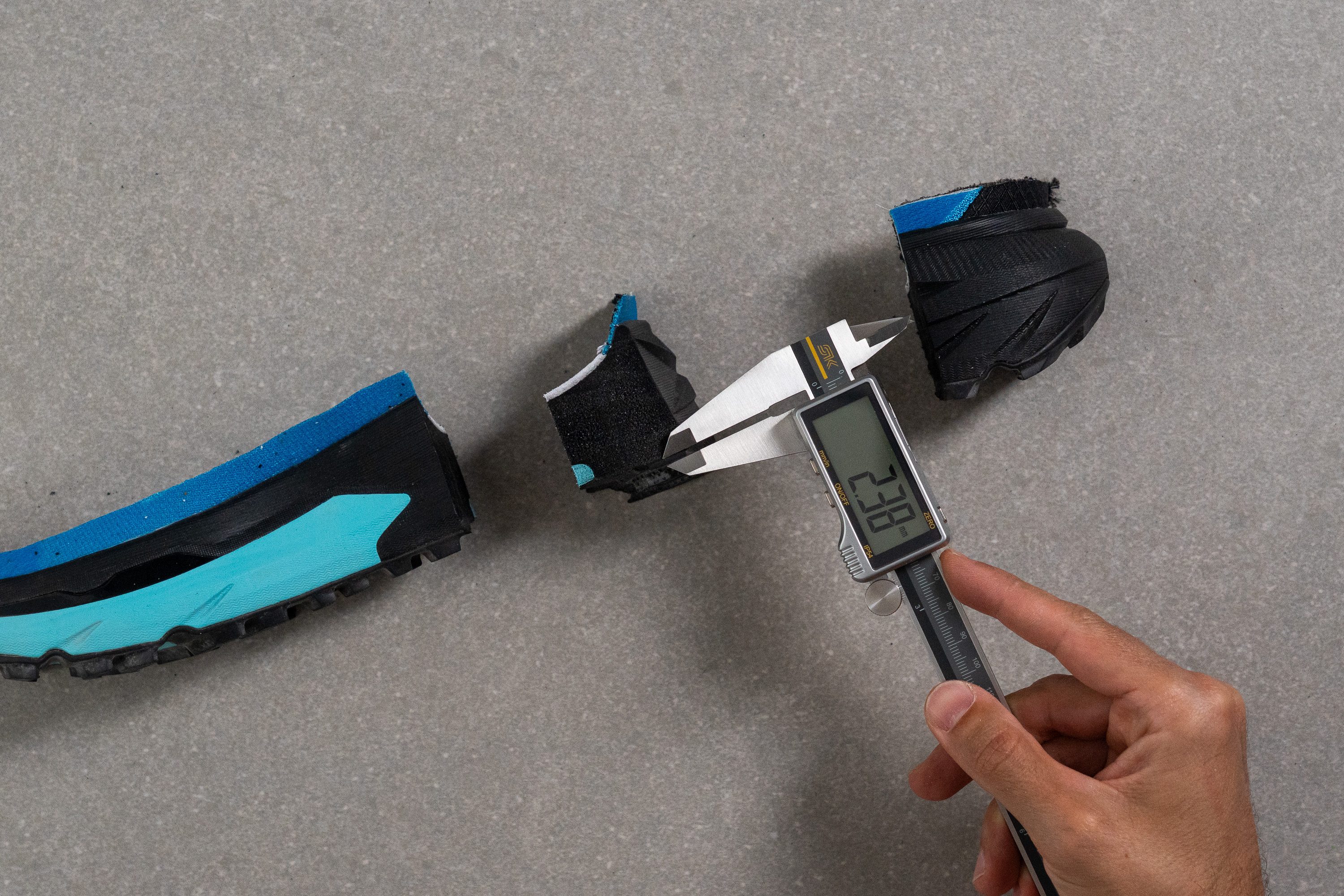
| Mafate 5 | 2.4 mm |
| Average | 2.2 mm |
Misc
Insole thickness
The insole measures 4.7 mm in thickness.
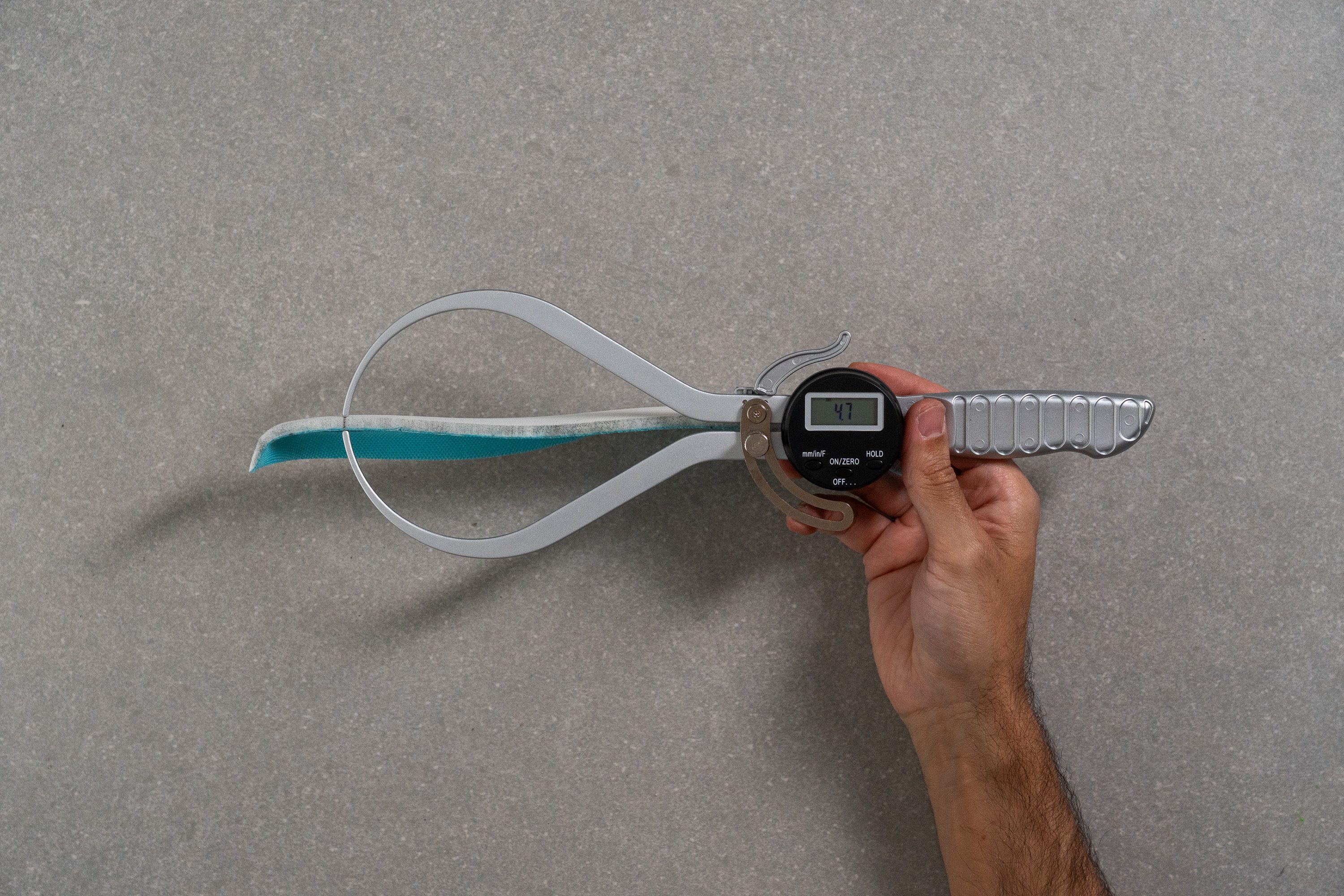
| Mafate 5 | 4.7 mm |
| Average | 4.7 mm |
Removable insole
The insole is removable, and because this HOKA offers a roomier fit than most of the brand’s models, third-party insoles fit better.
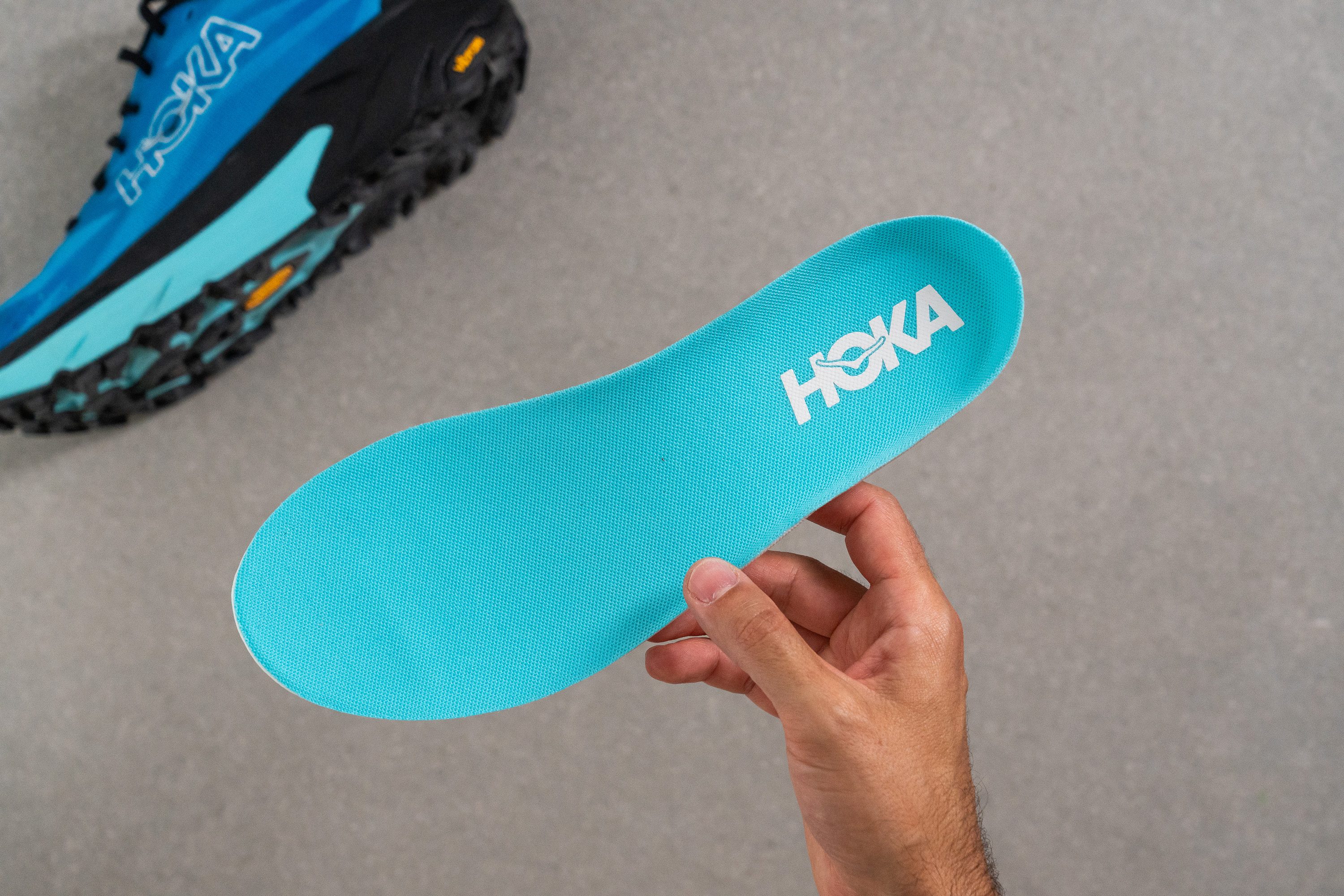
| Mafate 5 | Yes |
Midsole softness in cold (%)
Supercritical EVA is still EVA at its core, so it can’t perform miracles in cold conditions. However, it handled the challenge fairly well, showing a moderate 23% decrease in softness.
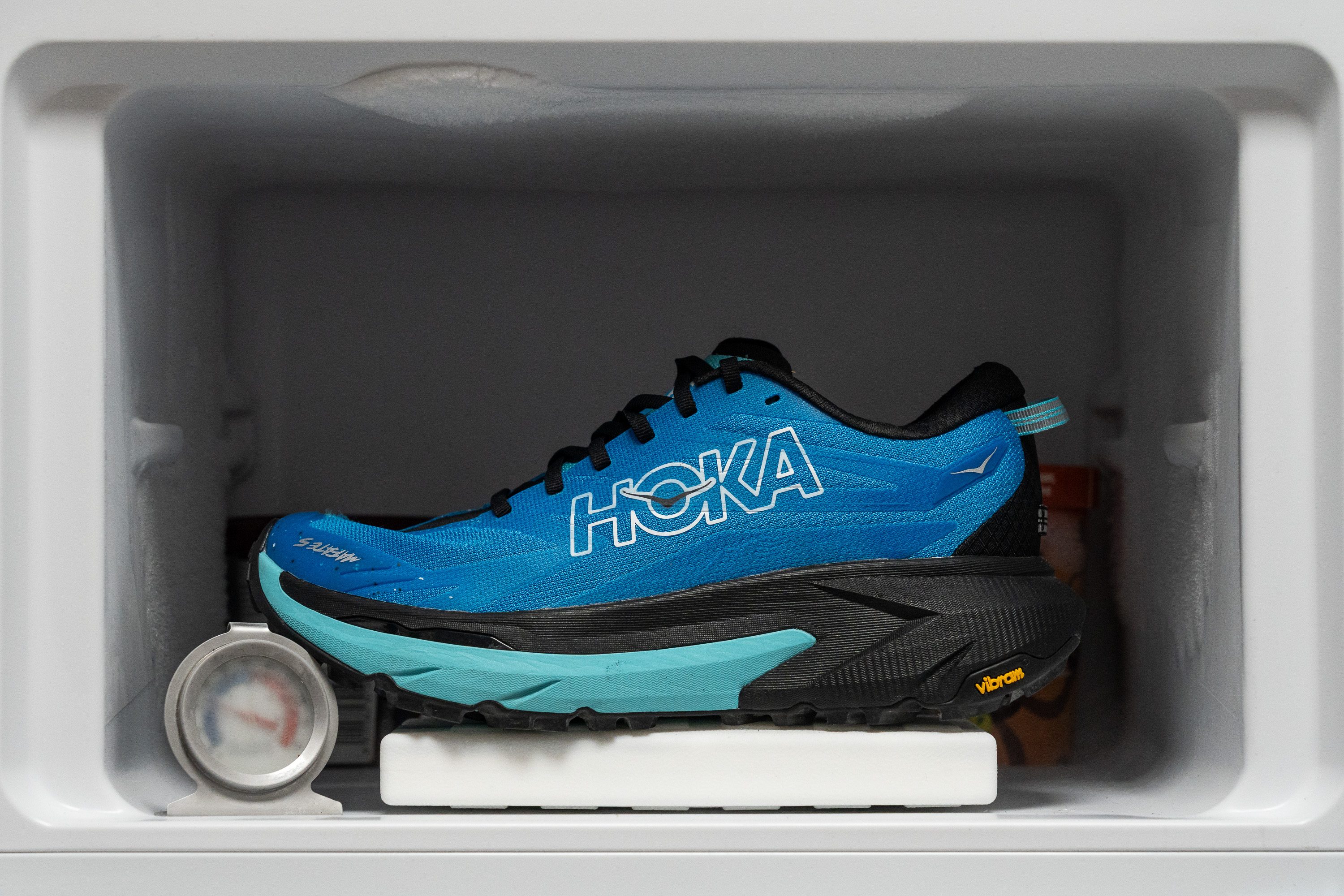
| Mafate 5 | 23% |
| Average | 26% |
Reflective elements
We discovered small yet cleverly placed reflective details on the Mafate 5, designed to enhance visibility from behind during nighttime runs.
| Mafate 5 | Yes |
Tongue padding
One of the things we really don’t like about the Mafate 5 is the tongue. We discovered several issues during our testing, and the most weird one is its ultra-short design, which clearly visible in our photo. Why do some brands suddenly insist on these odd tongues?
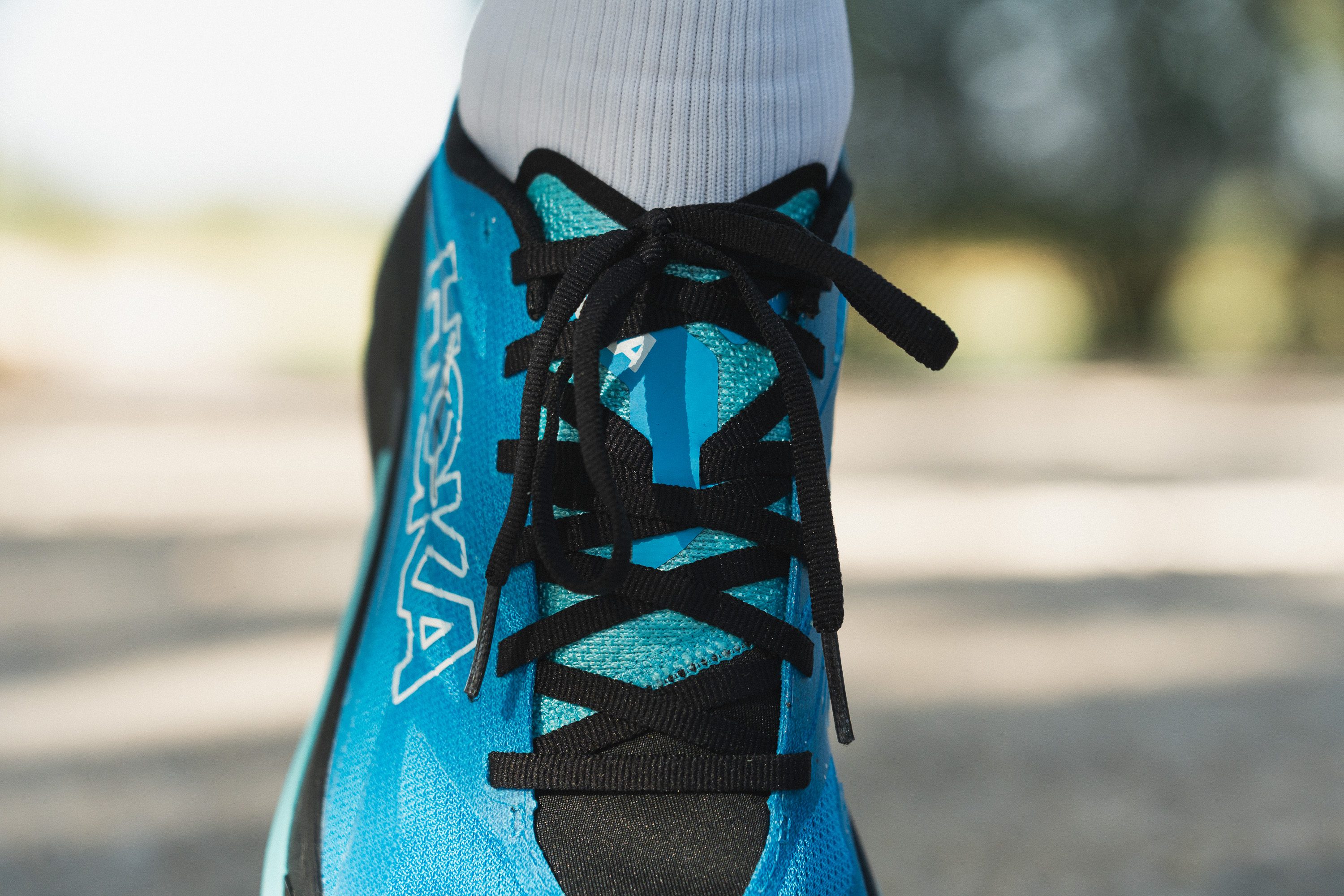
Beyond that, it features 6.0 mm of foam cushioning, yet it’s unevenly distributed, making the shoe far from easy to adjust. For us, it's probably the weakest aspect of this update.
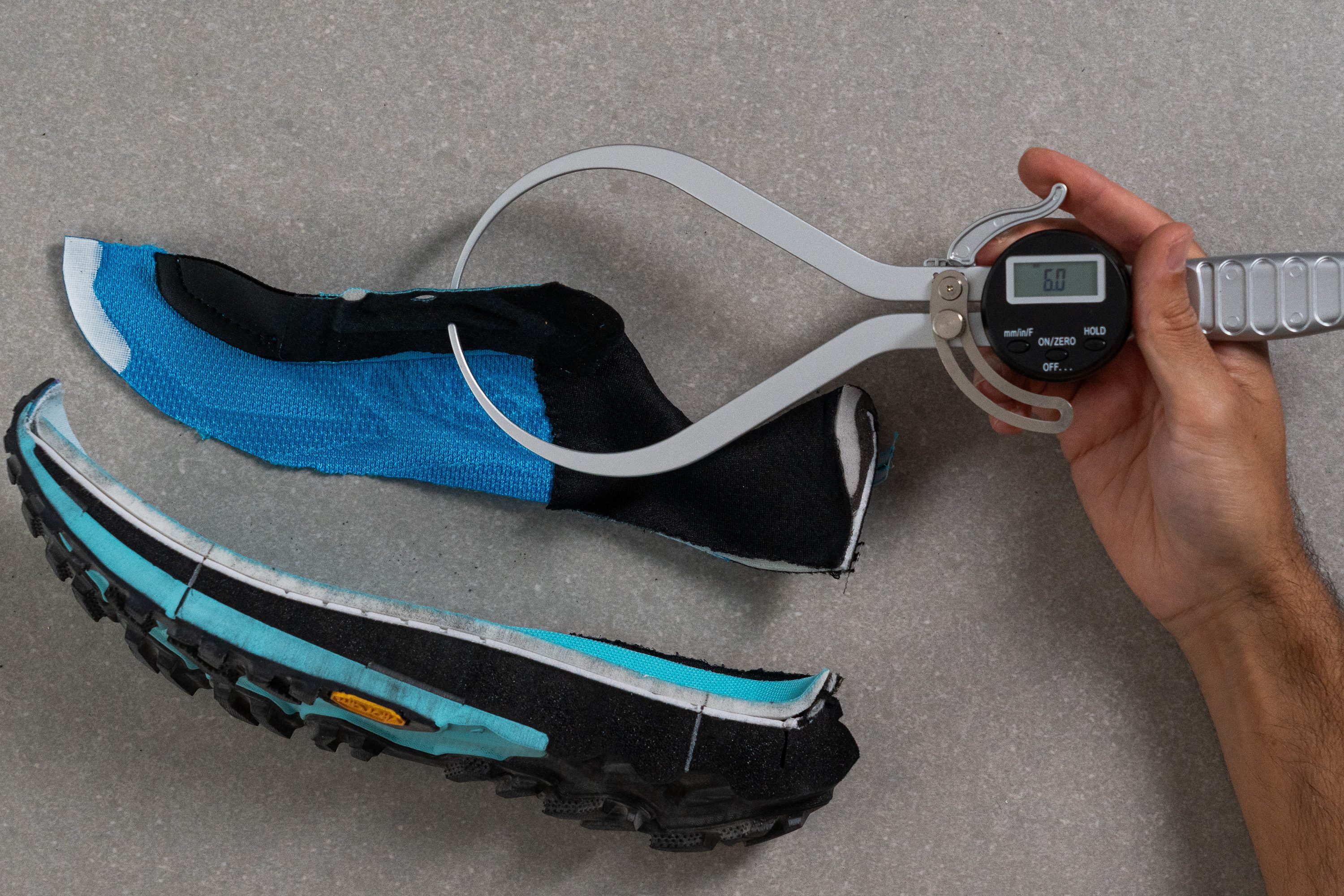
| Mafate 5 | 6.0 mm |
| Average | 6.4 mm |
Tongue: gusset type
When we first unboxed the shoe, we were surprised to find that the tongue is only attached at the bottom, leaving about 80% of it free to move and allowing debris to enter the toebox. That’s disappointing for a Mafate and could even be a deal-breaker for some runners.
However, we can’t say we’re shocked. The HOKA Mach X 3, which costs about the same, also features a non-gusseted tongue.
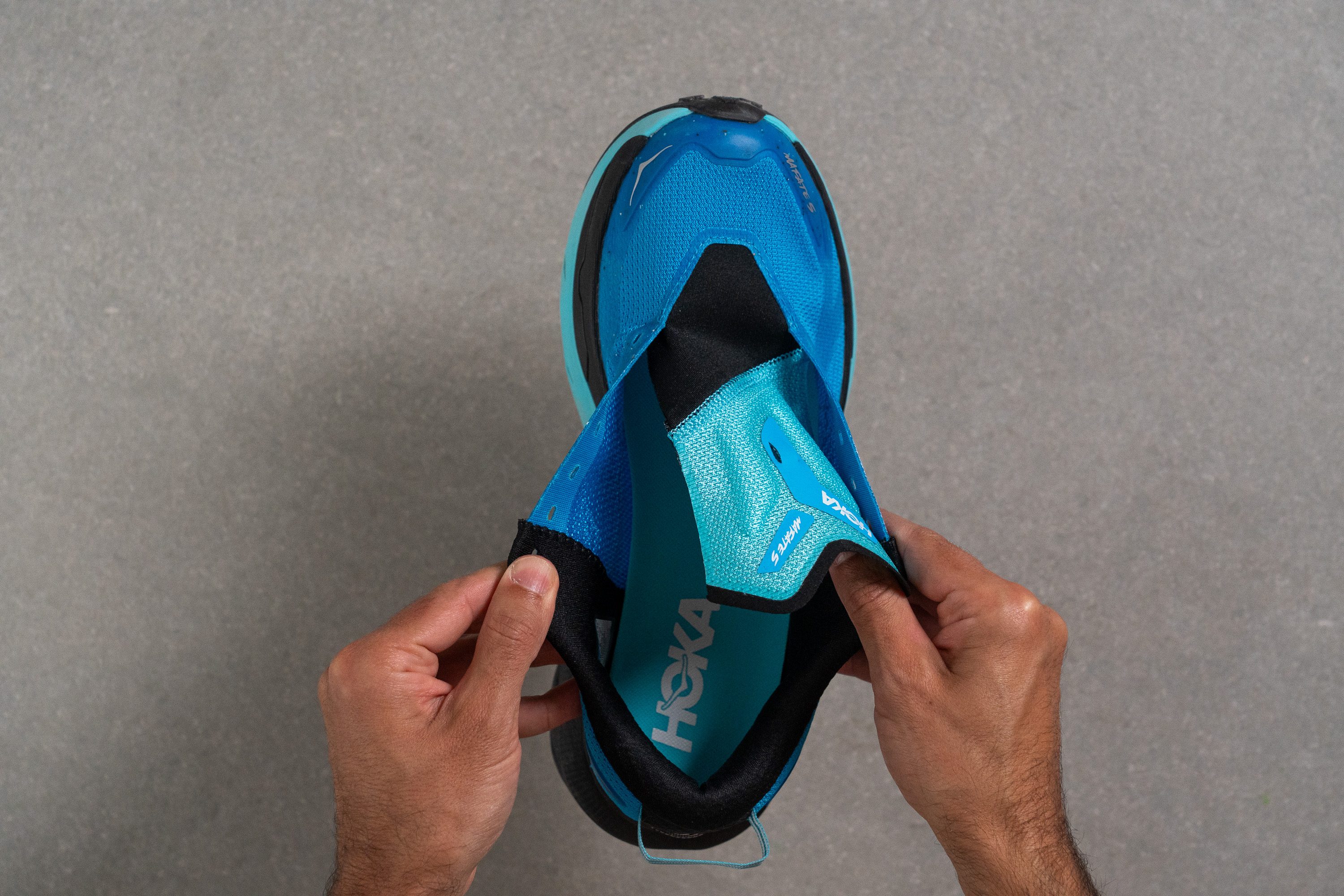
| Mafate 5 | None |
Price
The Mafate 5 retains the same price as its predecessor, which is great news. In a market where running shoe prices keep climbing, this feels like a win—especially since HOKA typically updates the Mafate series every two years.
That said, the Mafate 5 is already positioned in the premium category, so raising its price would have been a bold move. After all, asking $200 for a shoe made entirely of EVA foam would be hard to justify.
| Mafate 5 | $185 |
| Average | $153 |
Heel tab
The Mafate 5 features a translucent, high-quality heel tab that's really easy to grab. Just below it, there’s a gaiter attachment loop for added functionality.
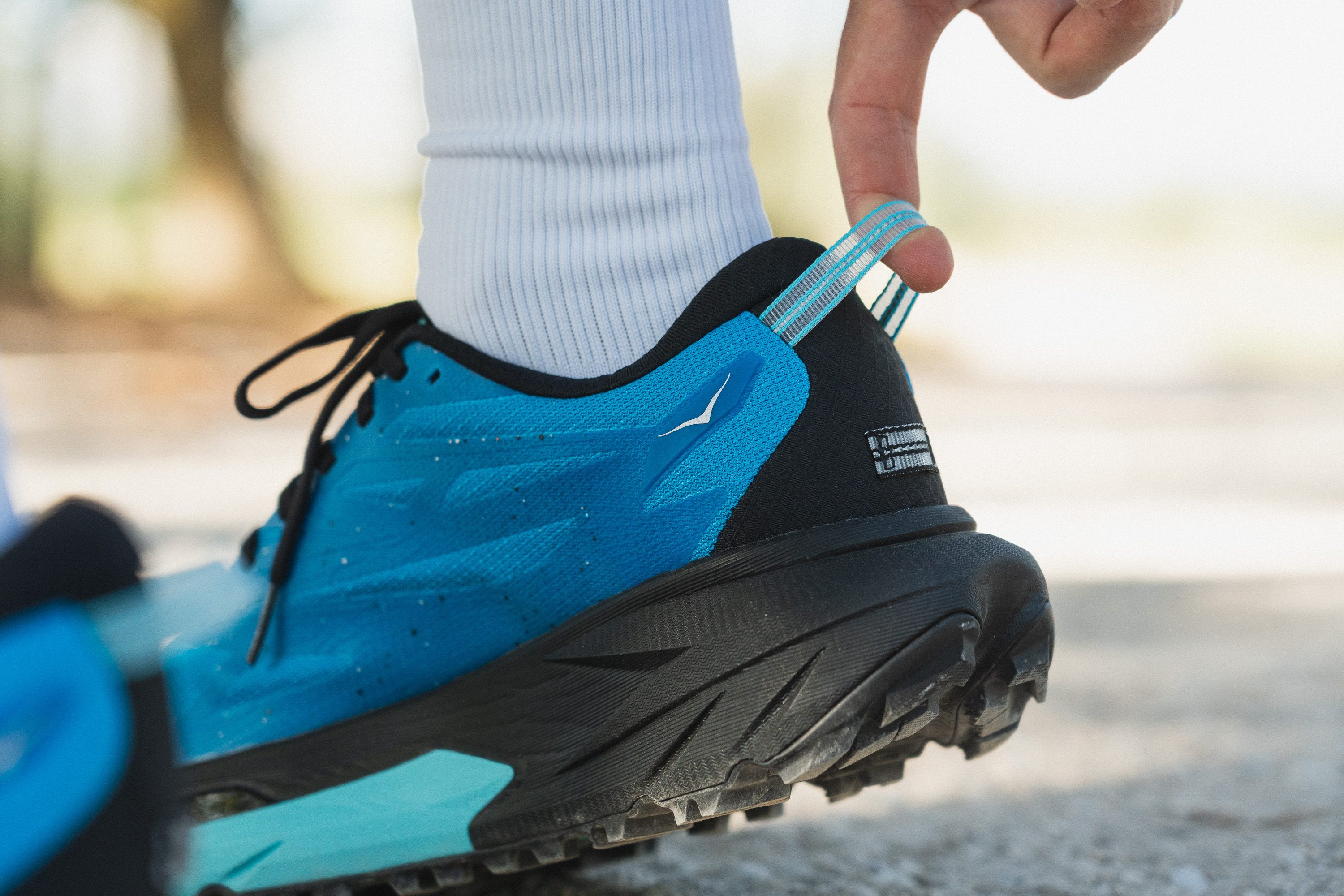
| Mafate 5 | Finger loop |

